Introduction
Every random map is generated following a certain template. The template prescribes, how many zones should map be divided into, how these zones should be interconnected, and certain details regarding zones and connections as well, while majority of objects and precise location of zones is selected randomly.
This article presents you description and layouts of default HotA templates.
Notation
Zones
- Zones are denoted by squares with rounded corners.
- Square size shows the relative size of the zone with respect to other zones on the template (however, actual size of the zone depends on the variety of factors and may not correspond to the size displayed on the layout).
- Zone color corresponds to a player whose starting town is located in this zone: this rule is held if only the first colors are selected by players (e.g., red and blue for two players), otherwise zone colors don’t correspond to players’ colors.
- Zones not occupied by players are colored white (for regular zones), silver (for treasures) or gold (for super-treasures).
- There is a number located at the bottom right corner of the square, which is this zone’s ID.
- PC icon located alongside zone number signifies that the player starting in this zone is imperatively AI-controlled.
- Zone that can only be placed on the surface or only underground is marked with a corresponding icon at the bottom of the zone image.
- A thick gray rim at the border of the zone means that this zone is of the “Junction” type (such a zone is filled with obstacles and contains only narrow passages connecting neighboring zones).
There is a number at the top left corner, near the chest icon, which denotes the richness of this zone’s contents. The bigger is this number, the more precious objects this zone will generate (and the heavier will be the guards). This number alone specifies, if the zone will be colored white, silver or gold.
Each zone’s contents are characterized by three (or less) content types. Each of these types is described by three numbers: minimum group value, maximum group value and relative frequency of occurrence. From now on each content type will be denoted as ([minimum value]–[maximum value], [frequency]).
The most frequently used content-wise zones are:
- 55 — regular zone, white. Content types: (500–3000, 9), (3000–6000, 6), (10000–15000, 1).
- 133 — treasure, silver. Content types: (3000–6000, 9), (10000–15000, 6), (15000–20000, 1).
- 242 — super-treasure, gold. Content types: (10000–15000, 9), (15000–20000, 6), (20000–30000, 1).
The asterisk above the richness number signifies that this zone uses custom rules for objects generation.
- Swords icon(s) at the top right corner denote the guards’ relative power. Absence of swords means that the objects in this zone are not guarded at all. Otherwise, 1, 2 or 3 swords correspond to weak, medium or strong guards respectively.
- There can be multiple towns in the zone. Town type (castles — with Fort; non-fortified, aka villages — without Fort) and amount is denoted by town icon(s) (castles — with windows; villages — without) and number(s) alongside them.
- Neutral and player-controlled towns are distinguished as well (neutral towns have grey tower tops, while player-controlled towns have tower tops of corresponding color).
- In case more than standard amount of towns may be generated, town density is displayed following the slash symbol.
- The amount of every type of mines is located alongside the corresponding resource icon.
- In case more than standard amount of mines may be generated, mine density is displayed following the slash symbol.
- Number and density of Airship Yard (if there are any in the zone) are displayed under the airship icon.
Connections
- Basic connection between two zones is denoted by a single black line. The number on it is connection value, which specifies the power of units guarding it.
- Unguarded connection has no value number.
- Connection with a Border Guard is crossed by another shorter line in place of the number.
- Wide connection is denoted by thick grey line. This connection is never guarded, and, if zones connected with it have a common land border, they will be connected for the majority of this border’s width.
- Thin dashed line denotes fictive connection: the zones will not be actually connected, but despite this fact, the generator will try to place these zones close to each other, if possible.
- If the connection has an obligatory road, thin white dashed line is added inside the connection line. Note that if several connections with obligatory roads occur between the same pair of zones, only one road will be generated.
- Imperatively roadless connections are denoted by thick dashed lines.
Conditions of existence
- Some zones and/or connections on the template may have a yellow outline. It means that this zone or connection may or may not appear during generation, depending on the map settings selected before start (number of players, map size). This way several templates may be configured differently, depending on the number of players or on the map size.
Mirror templates
Mirror templates have their underground layer generated as an exact copy of the surface level. On the template layouts surface zones are drawn at the left and the underground ones — to the right, they are separated with the red dashed line. Zone and its mirror copy share the same ID.
Note that the right side of the layout is usually turned upside-down — if some zone is found on the top of the left part of the scheme, its copy will be at the bottom of the right part.
The mirror links cross the red dashed line. The type and color of the mirror connection teleporter used is indicated next to the zone. Possible teleporters are:
- One-way monolith entrance: narrow 1-cell monolith or wide 2-cell portal, with an arrow pointing away from the zone;
- One-way monolith exit: narrow 1-cell monolith or wide 2-cell portal, with an arrow pointing to the zone;
- Two-way monolith: narrow 1-cell monolith or wide 2-cell portal;
- Subterranean Gate with the corresponding icon.
The connection lines between the entrance and exit of the one-way monolith are additionally marked with arrows.
If only entrances are present on the template for a one-way monolith of any color (there are no exits), then these entrances work as two-way monoliths. In the diagram, the lines of such connections do not contain arrows.
The value of the connection (in thousands), which determines the strength of its guard, is indicated next to the teleporter icon. If there is no guards, then the value is not indicated. Unlike a regular connection, a mirror connection may have different guard strength on different sides of the teleporter.
Mirror connection may have mandatory roads. In this case, like for regular connection, the connection line contains a white dashed line inside. However, there are some differences from the usual connections:
- If there are several mirror links with mandatory roads between the same pair of zones, all roads will be laid;
- The absence of a mandatory road in a mirror connection means that the road will never lead through this connection (as in a regular connection with prohibited roads).
Template editor
If you want more detailed view on any of the templates, you may open it using built-in template editor. To do so you need to run h3hota_tmpled.exe in the root directory of HotA, press Open and select HotA_RMGTemplates\[template name].h3t.
Note that there are multiple view modes, that may be switched using buttons 1–5.
- 1 is standard view, described above.
- 2 is towns and castles view. In this mode each zone displays all towns and castles total number, maximum allowed number of towns (if more than standard amount may be generated), allowed towns and castles alignment and notification if all the towns and castles in the zone must belong to the same alignment. It is also noted when there are town type generator rules for the zone.
- 3 is treasure view. In this mode each zone displays detailed view of its contents: minimum/maximum value and frequency for up to 3 types of treasures. Asterisk, as in the Standard view, signifies the custom settings or restrictions of certain objects generation.
- 4 is terrain/placement view. In this mode each zone displays allowed terrain types and noted when there are terrain type generator rules for the zone. Forced underground/surface level, allowed non-coherent roads zone repulsion are also displayed.
- 5 is IDs view. In this mode each zone’s ID is displayed in large scale.
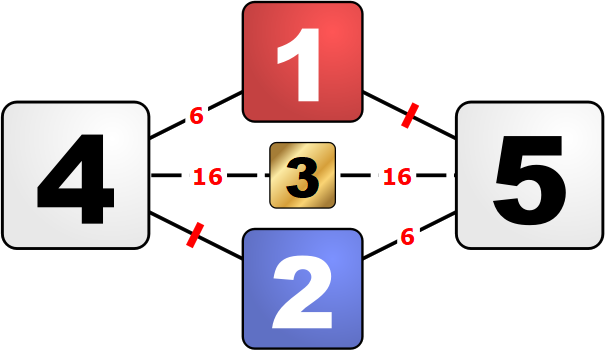
Double-clicking any zone or connection allows you to edit it. General settings can be viewed in the following tabs: Template pack > Settings and Template > Settings.
Protection from modifications
Host player templates are used to generate map during multiplayer session. Therefore joining players must have means to ensure the template doesn’t contain any unknown modifications.
At the beginning of new map generation all players have their templates compared between each other and with the reference template on HotA server. If no message appears after the check is performed, it means that host uses the template that is either to your corresponding template or corresponding reference template. Assuming that joining player has default template, it means that the host has also used the default template for map generation, and the players are free to proceed.
Otherwise the user is shown a message describing inconsistency type and possible solutions to this issue.
Default templates
Default Random Map
This template pack is also known as “Default” template. It is the template pack that was used in original game RMG (although its HotA version contains a number of improvements and additions).
The template pack consists of 56 different templates and is suitable for any map size and amount of players. A specific template from the pack is randomly selected before the map generation among the templates that suit the selected RMG settings.
This template pack is not optimized for professional multiplayer sessions, but it suits casual games of any number of players.
Default Random Map (Legacy)
This template pack is also known as “Default (Legacy)” template. A variant of the Default Random Map template pack with the game elements excluded from the standard HotA gameplay. It also contains 56 different templates without optimization for professional multiplayer sessions.
Specifications:
- Guards can be accepted for free. 100% of group is accepted.
- Allowed artifact assembling: Cloak of the Undead King.
- Allowed: Resistance, Thorgrim, Garniture of Interference, Surcoat of Counterpoise, and Boots of Polarity. Banned: Interference, Giselle, Charm of Eclipse, Seal of Sunset, and Plate of Dying Light.
- Spell research is disabled.
- Allowed heroes: Sir Mullich and Galthran; banned heroes: Lord Haart and Ranloo.
- Allowed artifacts: Orb of Inhibition and Recanter’s Cloak.
- Allowed objects: Sanctuary, Cartographer, original Hill Fort; Banned object: HotA Hill Fort.
- Value of Spell Scrolls is reduced: 4th level spells — from 8000 to 4000, 5th level spells — from 10000 to 5000, Fly/Dimension Door/Town Portal — from 20000 to 5000. Maximum amount of these Scrolls is increased from 3/2/1 to 4.
Mirror templates
h3dm1
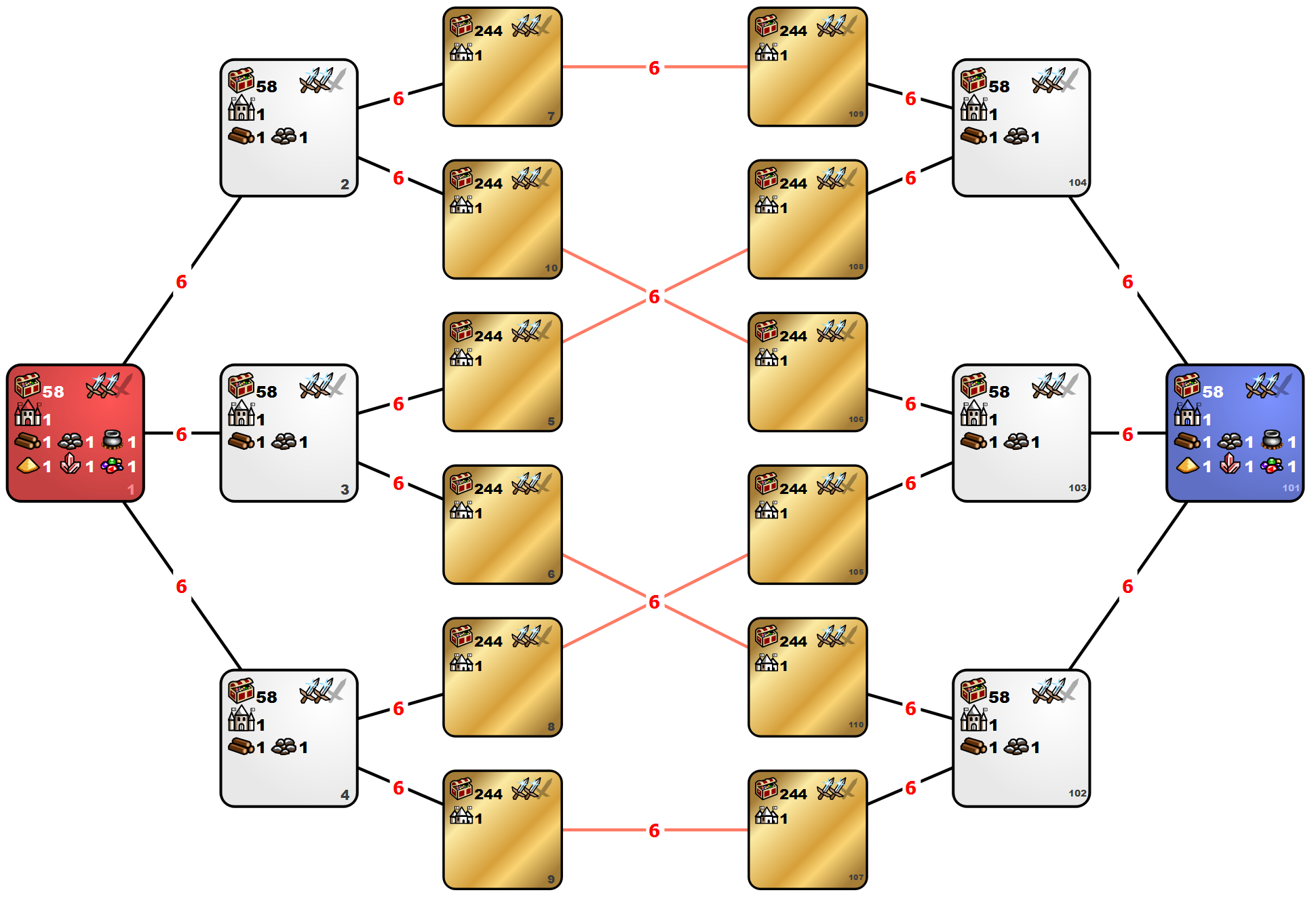
One of the most popular mirror templates. This template follows a simple gameplan: starting zone > secondary town zone > treasure zone. Treasure zones contain rich rewards, but are often small and lack the most valuable treasures, like Relic artifacts. Connection guards are considered difficult on the first week, but starting from the second week they become an easy goal, thus letting players to pass them and get in contact with their opponents. Although, early contact is not guaranteed due to complicated map topology, so players are forced to clear the treasure zones and conduct spell research, as on XL+U maps. This template is considered to be among the most balanced ones.
Specifications:
- Map size: L+U.
- Content types clarification:
- 58 (player zones and white zones): content types (100–3000, 12), (3000–6000, 6), (10000–15000, 1).
- 244 (gold zones): content types (6000–8999, 9), (10000–17000, 9), (17000–20000, 3).
- Mirror template. Underground is generated exactly similar to surface level. Zone content on the surface and in the underground is also the same.
- Zones 1–4 and their mirror copies have the native terrain of their corresponding town. Zones 5–10 and their mirror copies are generated with random terrain.
- Banned heroes: Kyrre, Giselle, Solmyr, Aislinn, Thant, Vidomina, Gunnar, Alamar, Jeddite, Deemer, Dessa, Luna, Ciele, Labetha, Grindan, Leena, Miriam.
- Banned objects: Shrine of Magic Mystery, external Tavern.
- Special weeks are disabled.
- Combat round limit is 100.
Suggested rules and settings:
mt_Diamond
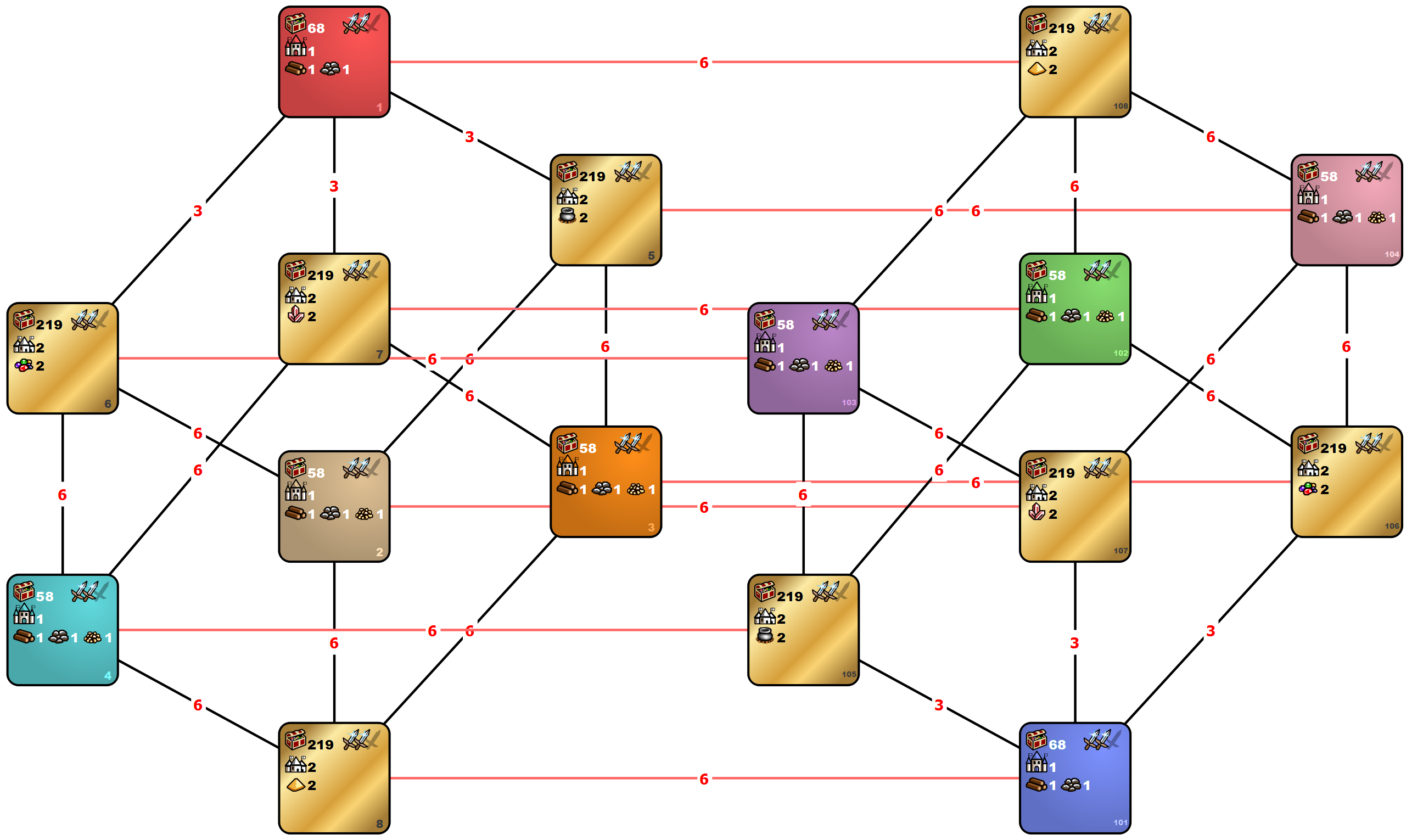
This template is a mirror variant of Diamond template. Each player has 3 easy passages to the treasure zones on their own level and one difficult passage to the treasure zone on opponent’s level. AI zones are located between the treasure zones. Treasure zones content varies from unguarded gold, as well as some other small rewards, to the objects of immense value, like Relic artifacts. Road network is enhanced, compared to Diamond’s.
Specifications:
- Map size: L+U.
- Content types clarification:
- 58 (player zones and AI zones): content types (100–3000, 12), (3000–6000, 6), (10000–15000, 1).
- 219 (gold zones): content types (100–3000, 9), (9000–20000, 9), (20000–30000, 3).
- Mirror template. Underground is generated exactly similar to surface level. Zone content on the surface and in the underground is also the same.
- Zones 1–4 and their mirror copies have the native terrain of their corresponding town. Zones 5–8 and their mirror copies are generated with random terrain.
- Different towns of the same zone are allowed to have different alignments.
- Non-coherent road networks are allowed inside all zones.
- Banned heroes: Kyrre, Giselle, Gunnar, Alamar, Jeddite, Dessa, Luna, Labetha, Grindan, Miriam.
- Banned object: Shrine of Magic Mystery.
- Special weeks are disabled.
- Combat round limit is 100.
Suggested rules and settings:
mt_Jebus

This template is a mirror variant of Jebus Cross template. Each player has a big and rich starting zone on their native terrain. There is also a heavily guarded access to an extra-rich central treasure zone. Central treasure zone consists of two parts, one on each layer, connected by unguarded portals. This treasure zone tends to be even richer than on original Jebus Cross maps.
Specifications:
- Map size: L+U.
- Content types clarification:
- 103 (player zones): content types (300–3000, 14), (5000–16000, 6), (12000–22000, 1).
- 610 (gold zones): content types (10000–25000, 10), (25000–35000, 10), (35000–55000, 3).
- Mirror template. Underground is generated exactly similar to surface level. Zone content on the surface and in the underground is also the same.
- Mirror teleporters are cross-connected: any portal leads to the portal with another coordinates on mirror plane.
- Mirror connection monoliths are repulsed from towns, land connection guards and each other.
- Zone 1 and its mirror copy have the native terrain of their corresponding town. Zone 2 and its mirror copy is always a sand zone.
- Different towns of the same zone are allowed to have different alignments.
- Banned heroes: Kyrre, Giselle, Gunnar, Alamar, Jeddite, Dessa, Luna, Labetha, Grindan, Miriam.
- Banned object: Shrine of Magic Mystery.
- Maximum amount of Taverns, Mineral Springs and Hermit’s Shacks per zone is increased to 3.
- Special weeks are disabled.
- Combat round limit is 100.
Suggested rules and settings:
mt_TeamJebus
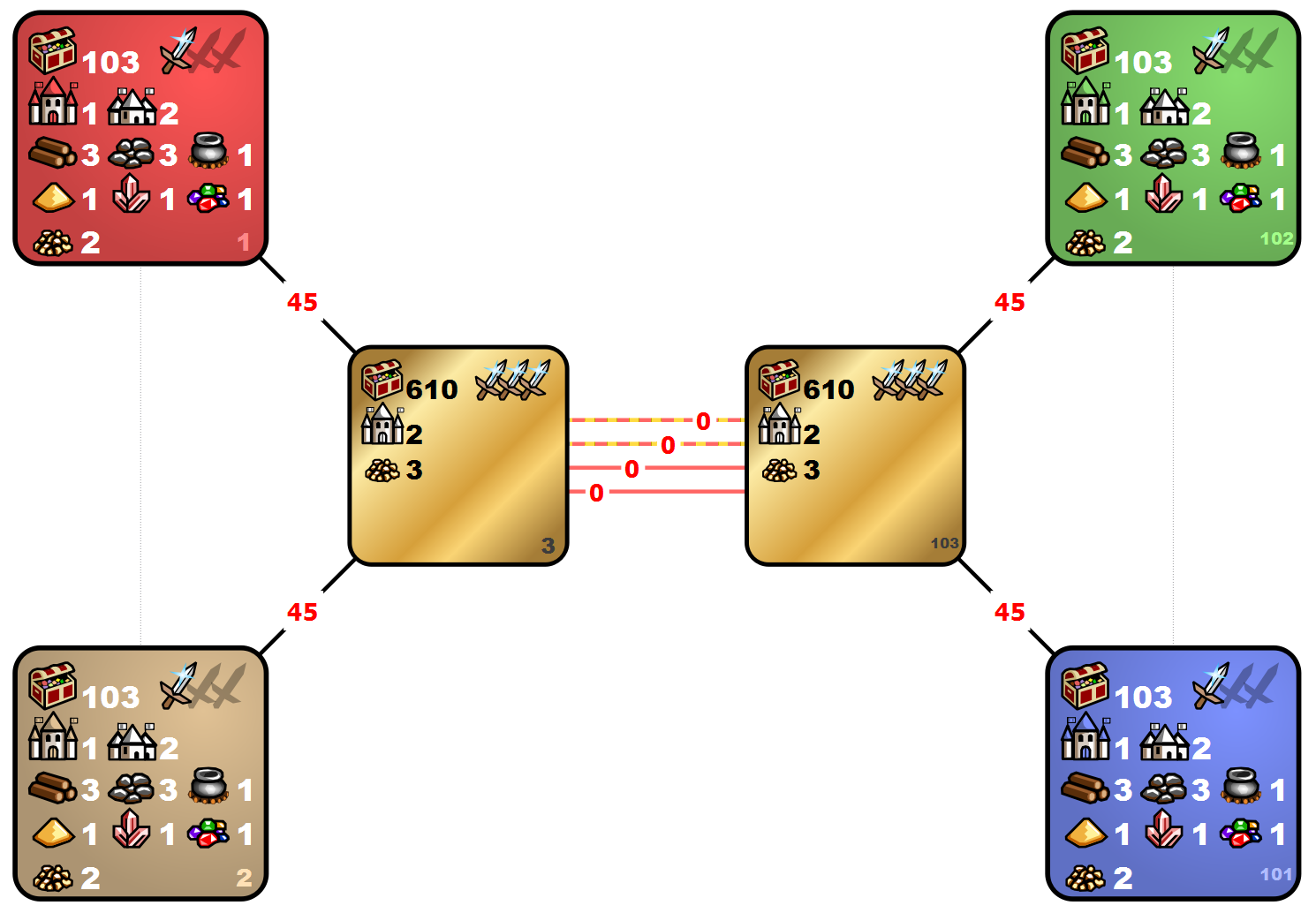
This template is a mirror variant of Jebus Cross template for 2v2 team games. Each player has a big and rich starting zone on their native terrain. There is also a heavily guarded access to an extra-rich central treasure zone. Ally zones lack direct connections, but hiring heroes in allied taverns, as well as using Town Portal spell is still available.
Specifications:
- Map size: L+U or M+U.
- Content types clarification:
- 103 (player zones): content types (300–3000, 14), (5000–16000, 6), (12000–22000, 1).
- 610 (gold zones): content types (10000–25000, 10), (25000–35000, 10), (35000–55000, 3).
- Mirror template. Underground is generated exactly similar to surface level. Zone content on the surface and in the underground is also the same.
- Mirror teleporters are cross-connected: any portal leads to the portal with another coordinates on mirror plane.
- On M+U size map only 1 pair of mirror connection is allowed, on L+U size map 2 pairs are present.
- Mirror connection monoliths are repulsed from towns, land connection guards and each other.
- Zone 1–2 and their mirror copies have the native terrain of their corresponding town. Zone 3 and its mirror copy is always a sand zone.
- Different towns of the same zone are allowed to have different alignments.
- Banned heroes: Kyrre, Giselle, Gunnar, Alamar, Jeddite, Dessa, Luna, Labetha, Grindan, Miriam.
- Banned object: Shrine of Magic Mystery.
- Maximum amount of Taverns, Mineral Springs and Hermit’s Shacks per zone is increased to 3.
- Special weeks are disabled.
- Combat round limit is 100.
Suggested rules and settings:
mt_Andromeda
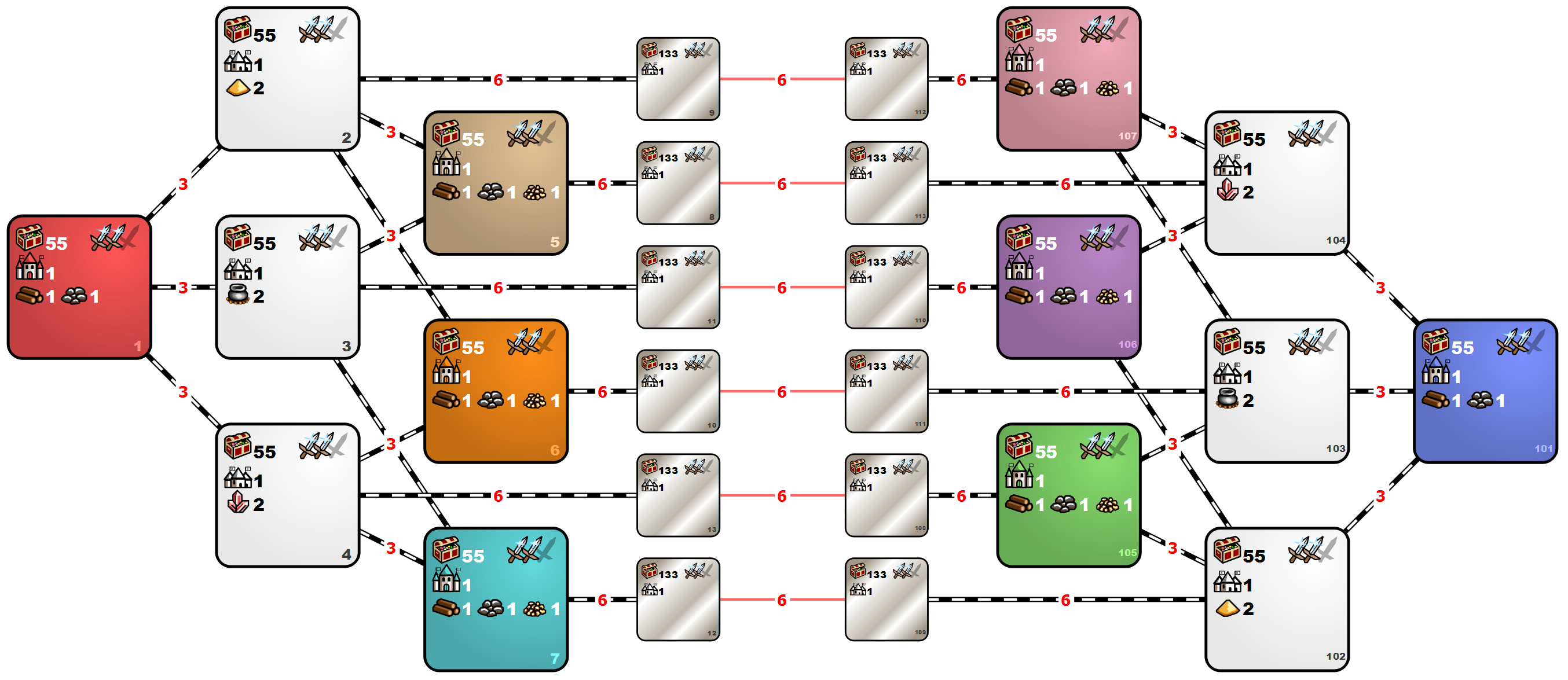
This is a mirror XL+U template, suitable for long and rather contactless games, heavily based on exploration and spell research. Treasure zones are not so rich and cannot contain Relic artifacts. Due to having underground tunnels replaced by fully functional surface layer, this template generates maps effectively bigger than regular XL+U, which is compensated by having obligatory roads for every connection.
Specifications:
- Map size: XL+U.
- Content types clarification:
- 55 (player zones, AI zones and white zones): content types (500–3000, 9), (3000–6000, 6), (10000–15000, 1).
- 133 (silver zones): content types (3000–6000, 9), (10000–15000, 6), (15000–20000, 1).
- Mirror template. Underground is generated exactly similar to surface level. Zone content on the surface and in the Underworld is also the same.
- Player zones and AI zones and have the native terrain of their corresponding town. The rest are generated with random terrain.
- All connections have obligatory roads.
- Banned heroes: Kyrre, Giselle, Gunnar, Alamar, Jeddite, Dessa, Luna, Labetha, Grindan, Miriam.
- Banned object: Shrine of Magic Mystery.
- Special weeks are disabled.
- Combat round limit is 100.
Suggested rules and settings:
mt_Antares
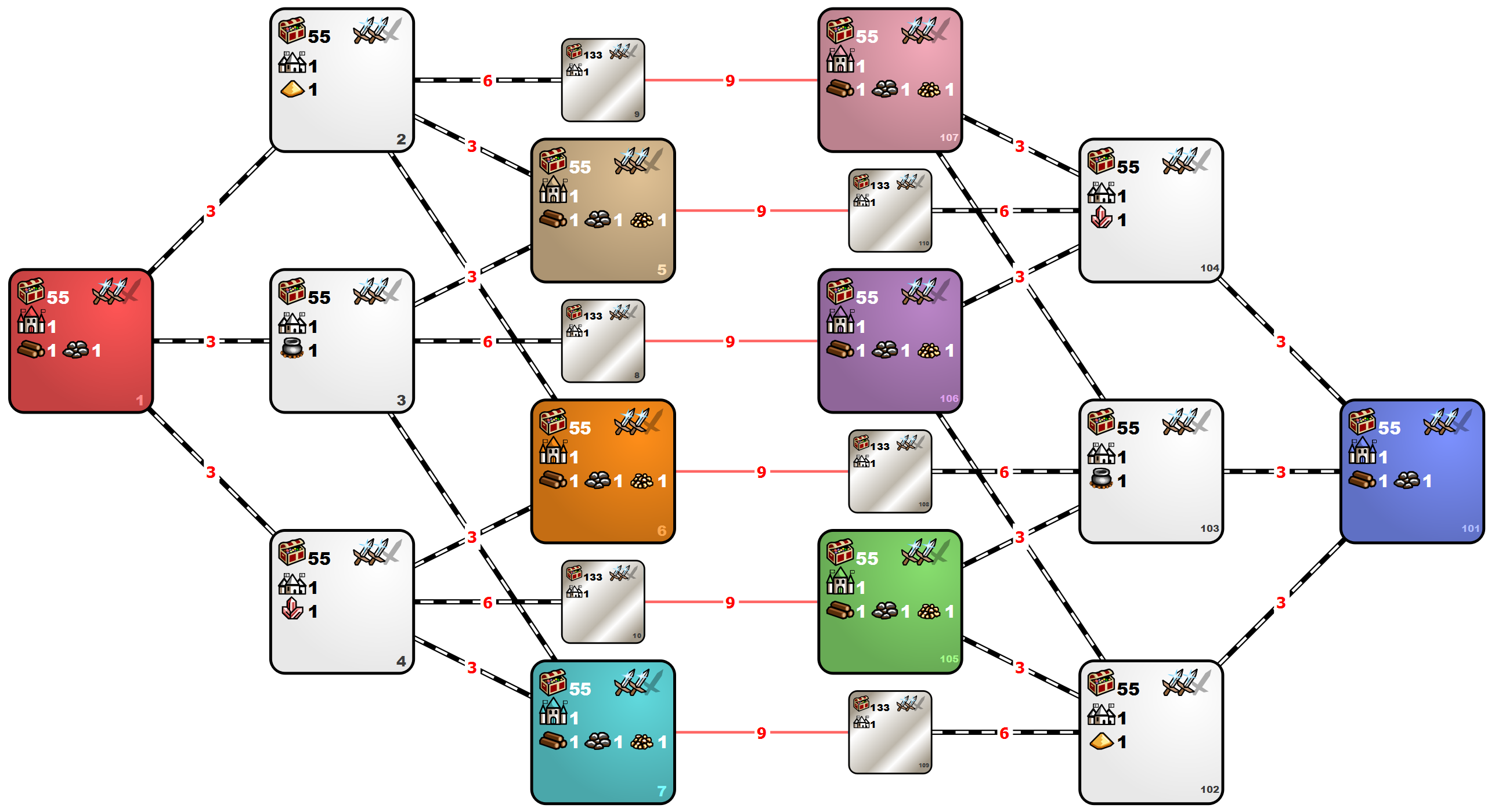
This is a mirror template for early contacts and quick expansion. It is topologically close to mt_Andromeda, but the gameplay differs greatly. Treasure zones are small and not so rich, cannot contain Relic artifacts as well.
Specifications:
- Map size: L+U.
- Content types clarification:
- 55 (player zones, AI zones and white zones): content types (500–3000, 9), (3000–6000, 6), (10000–15000, 1).
- 133 (silver zones): content types (3000–6000, 9), (10000–15000, 6), (15000–20000, 1).
- Mirror template. Underworld is generated exactly similar to surface level. Zone content on the surface and in the Underworld is also the same.
- Player zones and AI zones and have the native terrain of their corresponding town. The rest are generated with random terrain.
- All connections have obligatory roads.
- Banned heroes: Kyrre, Giselle, Gunnar, Alamar, Jeddite, Dessa, Luna, Labetha, Grindan, Miriam.
- Banned object: Shrine of Magic Mystery.
- Special weeks are disabled.
- Combat round limit is 100.
Suggested rules and settings:
mt_Firewalk
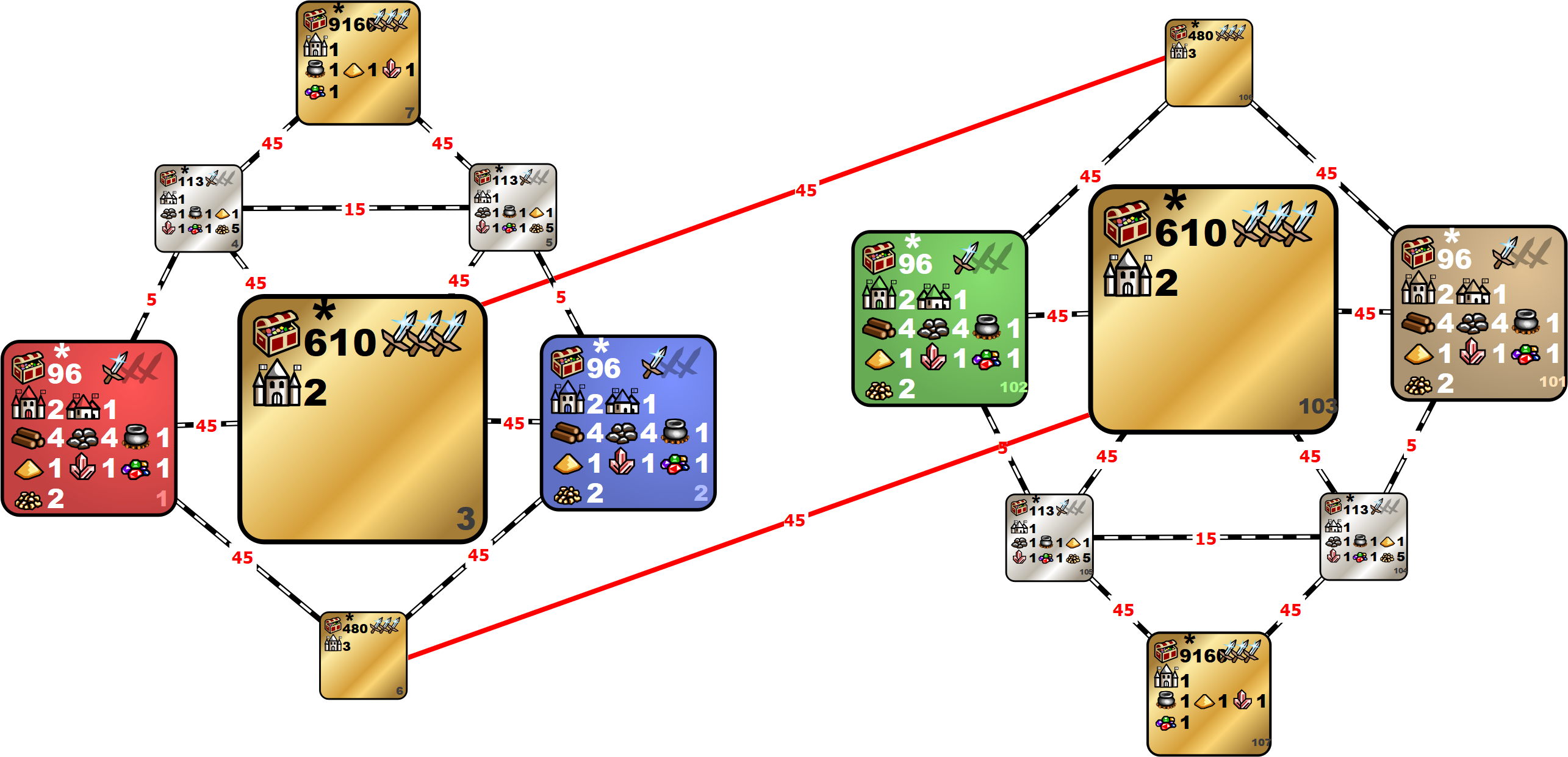
This template is mirror version of Firewalk template which has some object setting changed and is focused on dynamic game. Player starting zones contain 3 towns and are very rich, having 2 dwellings of 7th level and 3 dwellings of 6th level. Small white zones close to players contain Conflux villages, creature banks with gold as well as free piles gold. There are 3 types of rich treasures: army zones (containing creature objects), dragon utopia zones (containing Dragon Utopias) and big gold zones (that lead to the opponent plane).
General specifications:
- Map size: XL+U.
- Content types clarification:
- 96 (player zones and big white zones): content types (300–3000, 10), (5000–16000, 6), (12000–22000, 3).
- 78 (small white zones): content types (300–3000, 5), (3500–3500, 20).
- 79 (small white zones): content types (750–3000, 5), (3500–3500, 20).
- 610 (big gold zones): content types (10000–25000, 10), (25000–35000, 10), (35000–55000, 3).
- 480 (army zones): content types (7900–8100, 60).
- 9160 (dragon utopia zones): content types (8000–8000, 20), (45000–45000, 100), (45000–45000, 100).
- Mirror template. Underground is generated exactly similar to surface level. Zone content on the surface and in the underground is also the same.
- Mirror teleporters are cross-connected: any portal leads to the portal with another coordinates on mirror plane.
- Player zones (2) and big white zones (3) have the native terrain of their corresponding town. The central big gold zone (1) and dragon utopia zone (9) are generated on sand. Side big gold zones (4, 5) can have snow, swamp, rough, or wasteland terrain. Small white zones (6, 7) can have dirt, grass, or highlands terrain. Army zone (8) has rough, lava, or wasteland terrain.
- Starting player (1) and AI (2) zones have the native terrain of their corresponding town. Zone 3, 7 and their mirror copies are always sand zones. Zones 4, 5 and their mirror copies are always generated on dirt. Zone 6 and its mirror copy is always a lava zone.
- Each of zones 2 (player zone) and 3 (big white zone) have all towns of the same types. Towns in small white zones (4, 5) are always Confluxes.
- Banned heroes: Caitlin, Kyrre, Giselle, Elleshar, Iona, Daremyth, Solmyr, Ayden, Aislinn, Thant, Nagash, Gunnar, Alamar, Jeddite, Deemer, Sephinroth, Dessa, Andra, Luna, Labetha, Grindan, Miriam, Eovacius.
- Allowed artifacts: Orb of Inhibition and Recanter’s Cloak.
- Special weeks are disabled.
- Combat round limit is 100.
Suggested rules and settings:
Custom object generation rules:
Note: object generation settings are separated into 4 categories:
1. Banned objects doesn’t appear in the specified zone.
2. Allowed with default settings. This means that these objects are generated in certain zone similarly to any generic template. Neither object nor guard settings are changed.
3. Allowed with custom limits. These objects have almost the same settings as by default, but the maximum amount of them is limited. E.g., Churchyard with maximum of 1 per zone will have the same settings as on generic template, but there cannot be more than 1 Churchyard in this zone.
4. Allowed with custom frequency and/or value. In case the value is changed, this may affect the power of the monsters guarding this object — this is the most notable kind of change that can be applied to object generation settings, especially for more skilled players, who had already got used to default values. Frequency change may affect the number of objects of this type in a given zone, but, unlike changing the limits, this change is not so strict.Object bans and permissions apply in the order of appearance on the list. I.e., some global bans may be overridden by further permissions (e.g., banning all dwellings, then allowing 1 level dwellings will cause only level 1 dwellings to generate). This principle applies both on general template settings and on specifications for each zone.
Zones 2 and 3. Player zones and big white zones.
Creature objects: Griffin Conservatory, Dragon Fly Hive, Experimental Shop, Wolf Rider Picket, Red Tower
Dragon Utopia
Random relic artifact
Spell scroll level 4 and 5 (including Fly / Dimension Door / Town Portal)
Warrior’s Tomb
Refugee Camp
Prison
Quest artifacts for Seer’s Hut
Pandora’s Box with creatures
Pandora’s Box with spells
Pandora’s Box with gold
Allowed with custom zone limits:
Mercenary Camp, max per zone: 5
Marletto Tower, max per zone: 5
Star Axis, max per zone: 5
Garden of Revelation, max per zone: 5
School of War, max per zone: 5
School of Magic, max per zone: 5
Arena, max per zone: 3
Colloseum of the Magi, max per zone: 3
Library of Enlightenment, max per zone: 1
Allowed with custom value/frequency/limits:
Creature generators of level 6, frequency: 1000, max per zone: 3
Creature generators of level 7, frequency: 1000, max per zone: 2
Pandora’s Box with 5000 experience, frequency: 100
Pandora’s Box with 10000 experience, frequency: 50
Zone 1, 4, 5. Big gold zones.
Creature objects: Griffin Conservatory, Dragon Fly Hive, Experimental Shop, Wolf Rider Picket, Red Tower
Creature generators
Dragon Utopia
Creature banks with gold: Imp Cache, Dwarven Treasury, Medusa Stores, Naga Bank, Mansion
Treasure chest
Gold (random resource is allowed)
Quest artifacts for Seer’s Hut
Pandora’s Box with gold
Pandora’s Box with 5000 or 10000 experience
Pandora’s Box with spells from specific levels and with all spells (Pandora’s Boxes with all spells from certain School are allowed)
Prison
Allowed with custom zone limits:
Prison (hero with 0 exp), max per zone: 6
Library of Enlightenment, max per zone: 5
Zone 7. Small white zone (without minor objects).
All objects are banned. Allowed objects are listed below individually.
Allowed with default settings:
Treasure Chest
Campfire
Resource piles: wood, mercury, ore, sulfur, crystals, gems, gold, random resource
Allowed with custom zone limits:
Crypt, max per zone: 3
Churchyard, max per zone: 3
Windmill, max per zone: 3
Water Wheel, max per zone: 3
Mystical Garden, max per zone: 3
Allowed with custom value/frequency/limits:
Imp Cache, value: 3500, frequency: 10000, max per zone: 8
Dwarven Treasure, value: 3500, frequency: 10000, max per zone: 8
Medusa Stores, 3500, frequency: 10000, max per zone: 8
Naga Bank, value: 3500, frequency: 10000, max per zone: 8
Trading Post, value: 500, frequency: 10000, max per zone: 3
Stables, value: 500, frequency: 10000, max per zone: 2
Zone 6. Small white zone (with minor objects).
All objects are banned. Allowed objects are listed below individually.
Allowed with default settings:
Treasure Chest
Campfire
Resource piles: wood, mercury, ore, sulfur, crystals, gems, gold, random resource
Warehouses of wood, mercury, ore, sulfur, crystal, gems, gold
Ruins
Redwood Observatory
Den of Thieves
Mineral Spring
Rally Flag
Fountain of Youth
Fountain of Fortune
Idol of Fortune
Faerie Ring
Swan Pond
Allowed with custom zone limits:
Crypt, max per zone: 3
Churchyard, max per zone: 3
Windmill, max per zone: 3
Water Wheel, max per zone: 3
Mystical Garden, max per zone: 3
Allowed with custom value/frequency/limits:
Imp Cache, value: 3500, frequency: 10000, max per zone: 8
Dwarven Treasure, value: 3500, frequency: 10000, max per zone: 8
Medusa Stores, 3500, frequency: 10000, max per zone: 8
Naga Bank, value: 3500, frequency: 10000, max per zone: 8
Trading Post, value: 500, frequency: 10000, max per zone: 3
Stables, value: 500, frequency: 10000, max per zone: 2
Zone 8. Gold army zone.
All objects are banned. Allowed objects are listed below individually.
Allowed with default settings:
Resource piles: wood, mercury, ore, sulfur, crystals, gems, random resource (no separate gold)
Allowed with custom value/frequency/limits:
Griffin Conservatory, value: 8000, frequency: 10000, max per zone: 4
Dragon Fly Hive, value: 8000, frequency: 10000, max per zone: 6
Experimental Shop, value: 8000, frequency: 10000, max per zone: 4
Wolf Rider Picket, value: 8000, frequency: 10000, max per zone: 6
Red Tower, value: 8000, frequency: 10000, max per zone: 4
Zone 9. Gold dragon utopia zone on sand.
All objects are banned. Allowed objects are listed below individually.
Allowed with default settings:
Resource piles: wood, mercury, ore, sulfur, crystals, gems, random resource (no separate gold)
Allowed with custom value/frequency/limits:
Dragon Utopia, value: 45000, frequency: 10000, max per zone: 8
XL+U templates
6lm10a
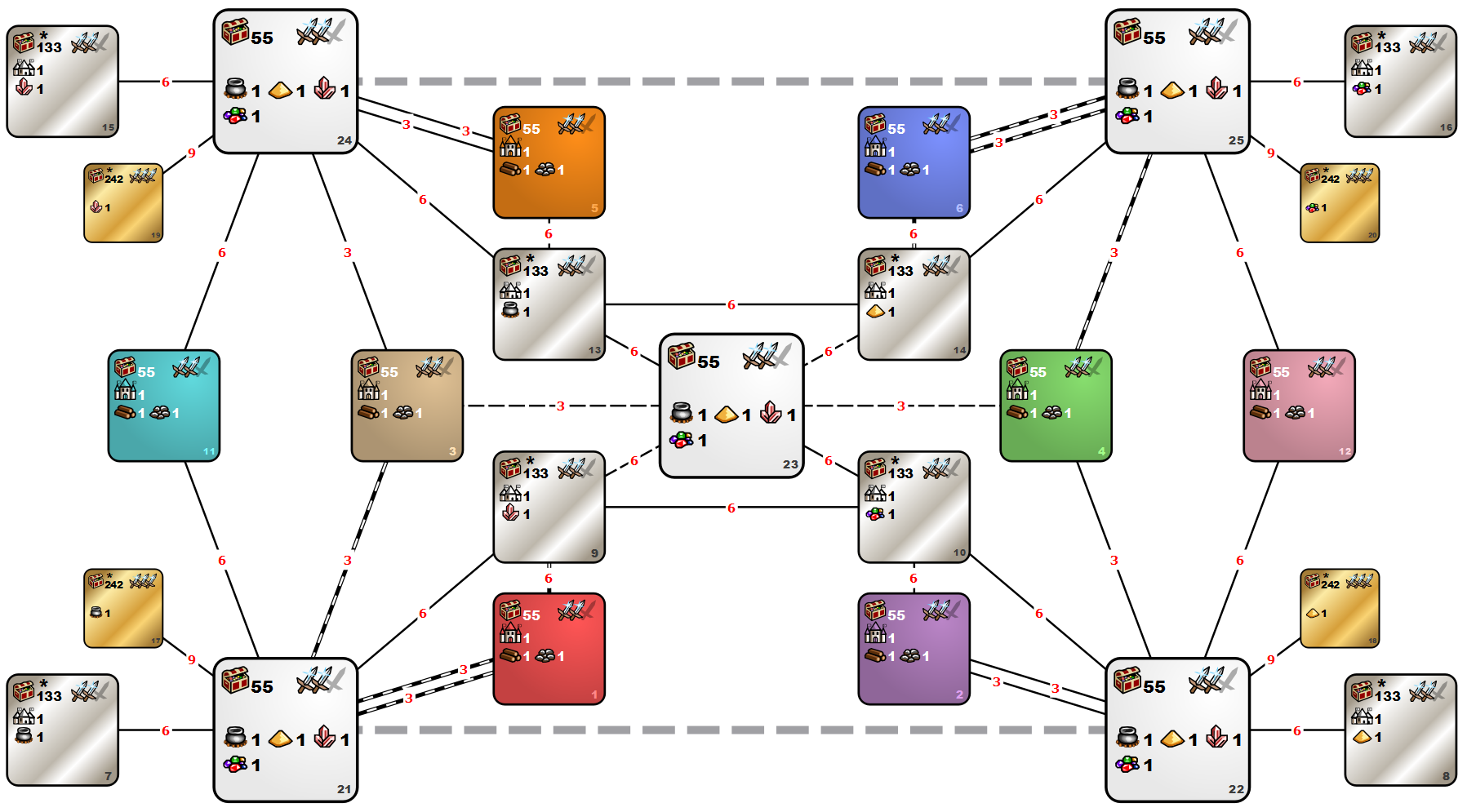
This is one of the most popular XL+U templates. Map layout is heavily branched, and therefore there is no distinct centre. Vast territories are available for players’ exploration, which makes this template quite well-balanced. Both players explore, conduct spell research and usually don’t contact each other, unless one of them does it intentionally. There is some variety in treasure zones: 4 gold zones (which may contain Relic artifacts) being the most valuable, but hard to access, because all connections that lead there are imperatively roadless.
Specifications:
- Map size: XL+U.
- Content types clarification:
- 55 (player zones, AI zones and white zones): content types (500–3000, 9), (3000–6000, 6), (10000–15000, 1).
- 133 (silver zones): content types (3000–6000, 9), (10000–15000, 6), (15000–20000, 1).
- 242 (gold zones): content types (10000–15000, 9), (15000–20000, 6), (20000–30000, 1).
- All zones with towns have the native terrain of their corresponding town. Zones without towns are generated with random terrain.
- Banned object: Shrine of Magic Mystery.
- Dragon Utopia frequency is increased to 200. Player and AI zones (1–6, 11–12) and intermediary zones (21–25) may have no more than 1 Dragon Utopia generated. Regular treasure zones (7–10, 13–16) may have no more than 2 Dragon Utopias generated. Greater treasure zones (17–20) have no limit on Dragon Utopia number.
- Special weeks are disabled.
- Combat round limit is 100.
Road placement variations:
- Obligatory roads 3–21–1–9–10 and 4–25–6–14–13 (2 roads per starting zone for red and blue players and the roads to the neighboring treasures).
- Forced roadless connections: 3–23, 4–23, 9–23, 14–23 (shortcuts to the center) and 21–22, 24–25 (unguarded connections).
But in fact 6lm10a has 5 varieties with specified road networks. A random one of them is chosen during a map generation. The template varieties are only differ in the road settings.
6lm10aN1
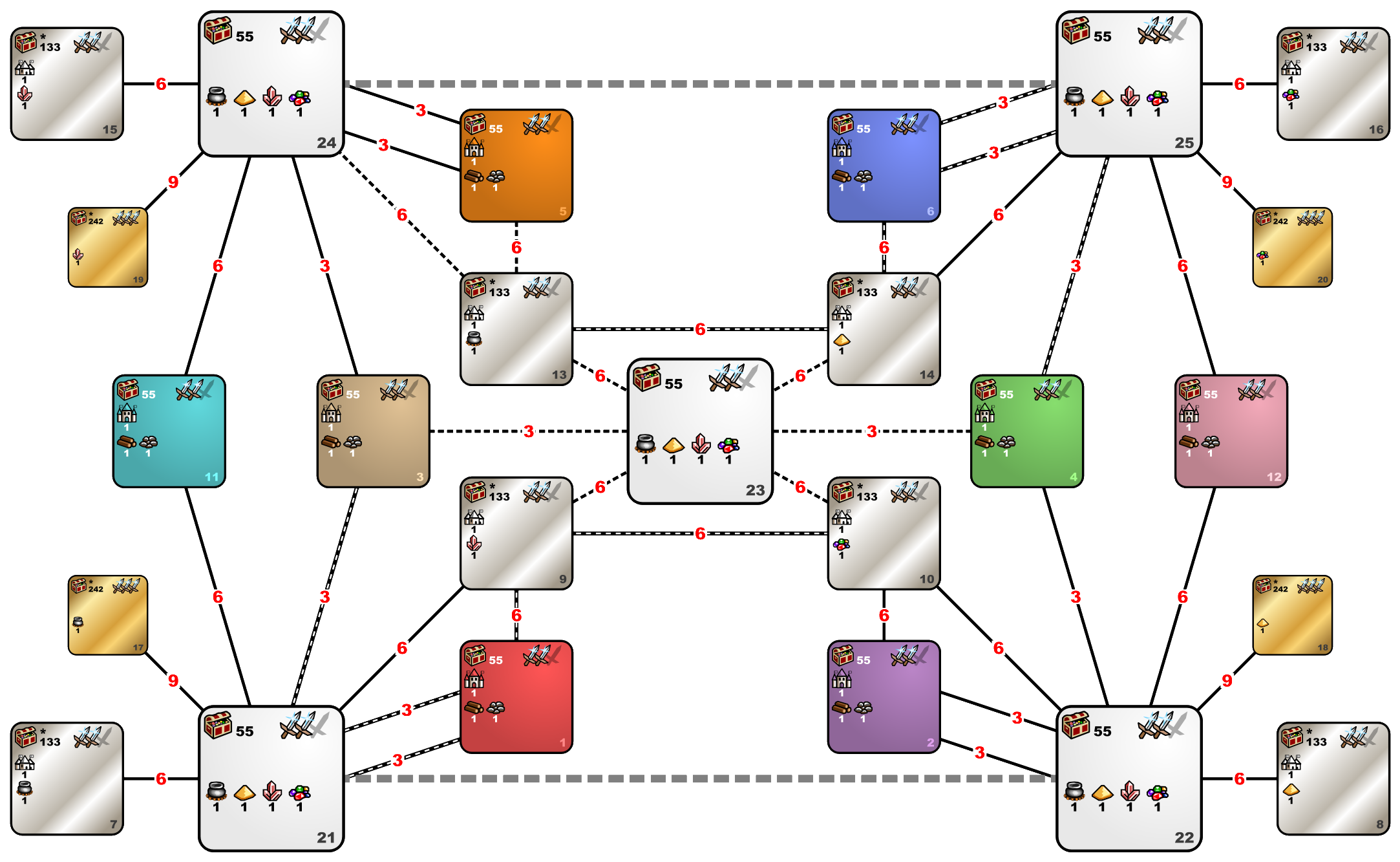
The roads to the central zone (23) as well as from the blue player area (13) to the orange (5 and 24) are disabled.
The orange is included in the red player area of influence, while the neighboring treasure 13 is in the blue player area. The road between red and blue players is in purple area (goes through zone 10).
6lm10aN2
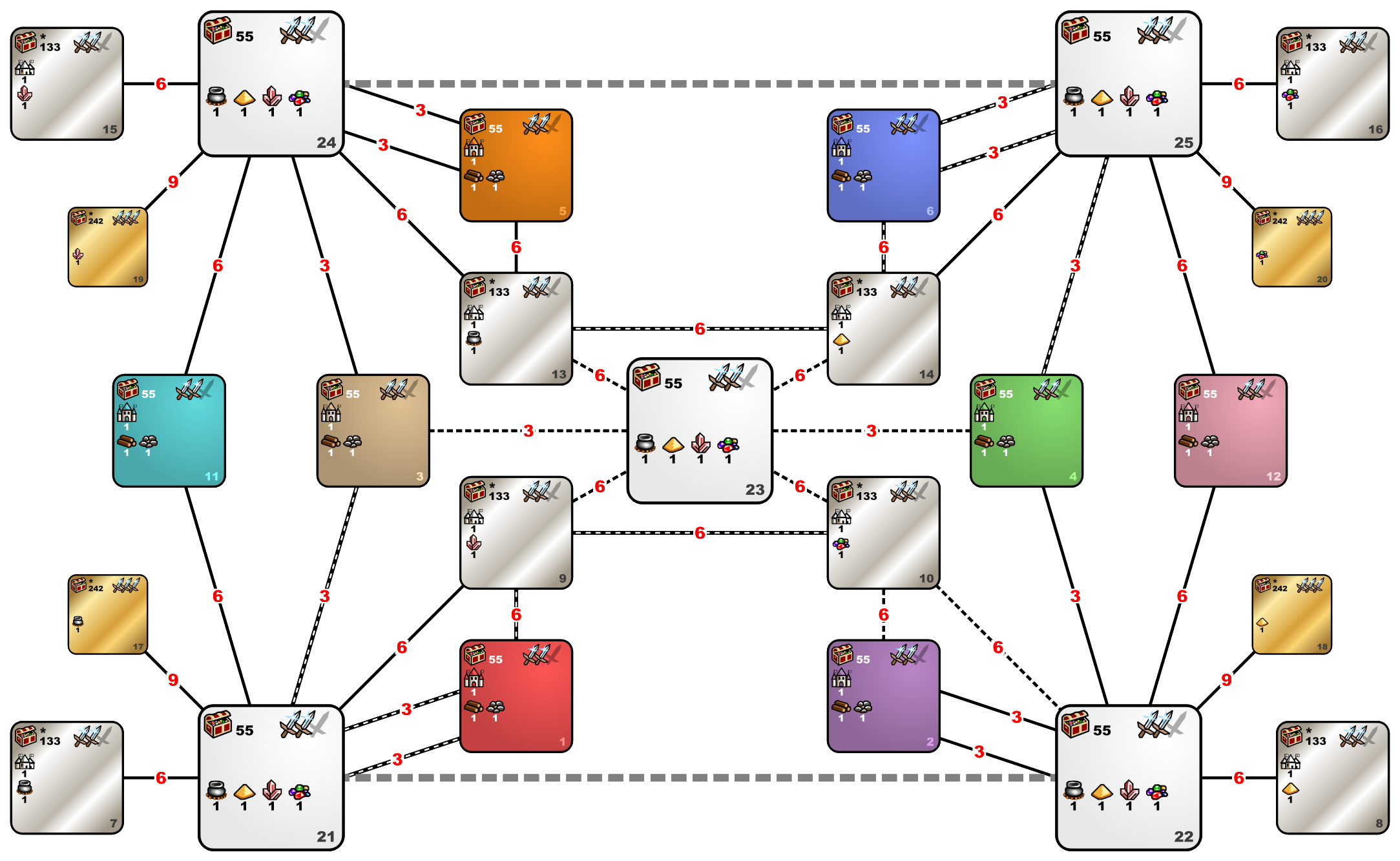
A variation symmetric to 6lm10aN1.
The roads to the central zone (23) as well as from the red player area (10) to the purple (2 and 22) are disabled.
The purple is included in the blue player area of influence, while the neighboring treasure 10 is in the red player area. The road between red and blue players is in orange area (goes through zone 13).
6lm10aN3
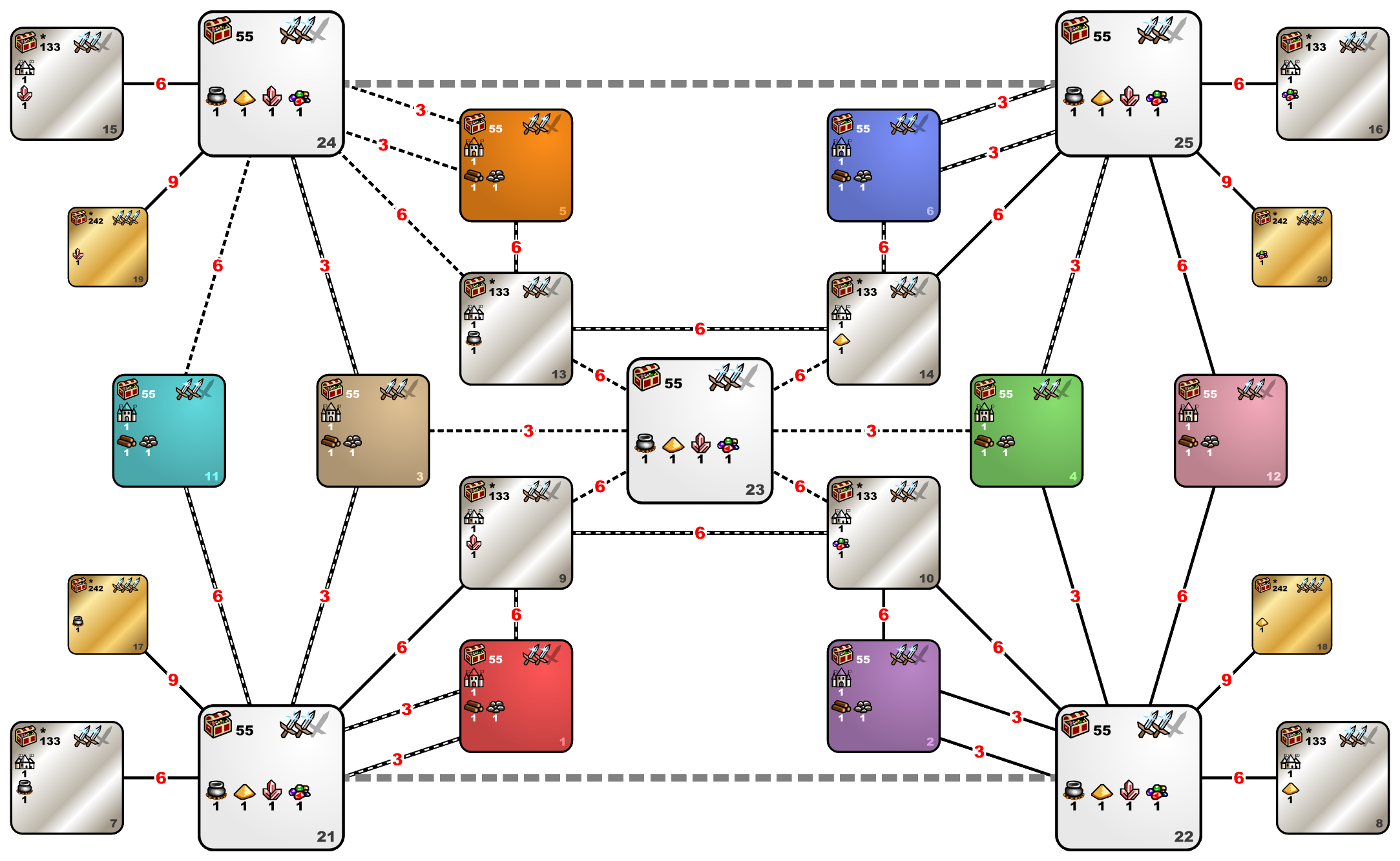
6lm10aN1 analogue with the orange included in the blue player area (not the red one).
The roads to the central zone (23) as well as from the orange (5 and 13) to the red player area (24) are disabled. The blue has the road ensured from the treasure 13 to the orange (5). The red has the roads ensured from their intermediate zone 21 to their computers (tan 3 and teal 11) as well as the road from the tan zone 3 to the intermediate zone 24 with weak guards (3000 value).
The orange with the neighboring treasure 13 are included in the blue player area of influence, while the red player has more convenient roads to their computer players. The road between red and blue players is in the purple area (goes through zone 10).
6lm10aN4

A variation symmetric to 6lm10aN3, and also a 6lm10aN2 analogue with the purple included in the red player area (not the blue one).
The roads to the central zone (23) as well as from the purple (2 and 10) to the blue player area (22) are disabled. The red has the road ensured from the treasure 10 to the purple (2). The blue has the roads ensured from their intermediate zone 25 to their computers (green 4 and pink 12) as well as the road from the green zone 4 to the intermediate zone 22 with weak guards (3000 value).
The purple with the neighboring treasure 10 are included in the red player area of influence, while the blue player has more convenient roads to their computer players. The road between red and blue players is in the orange area (goes through zone 13).
6lm10aN5
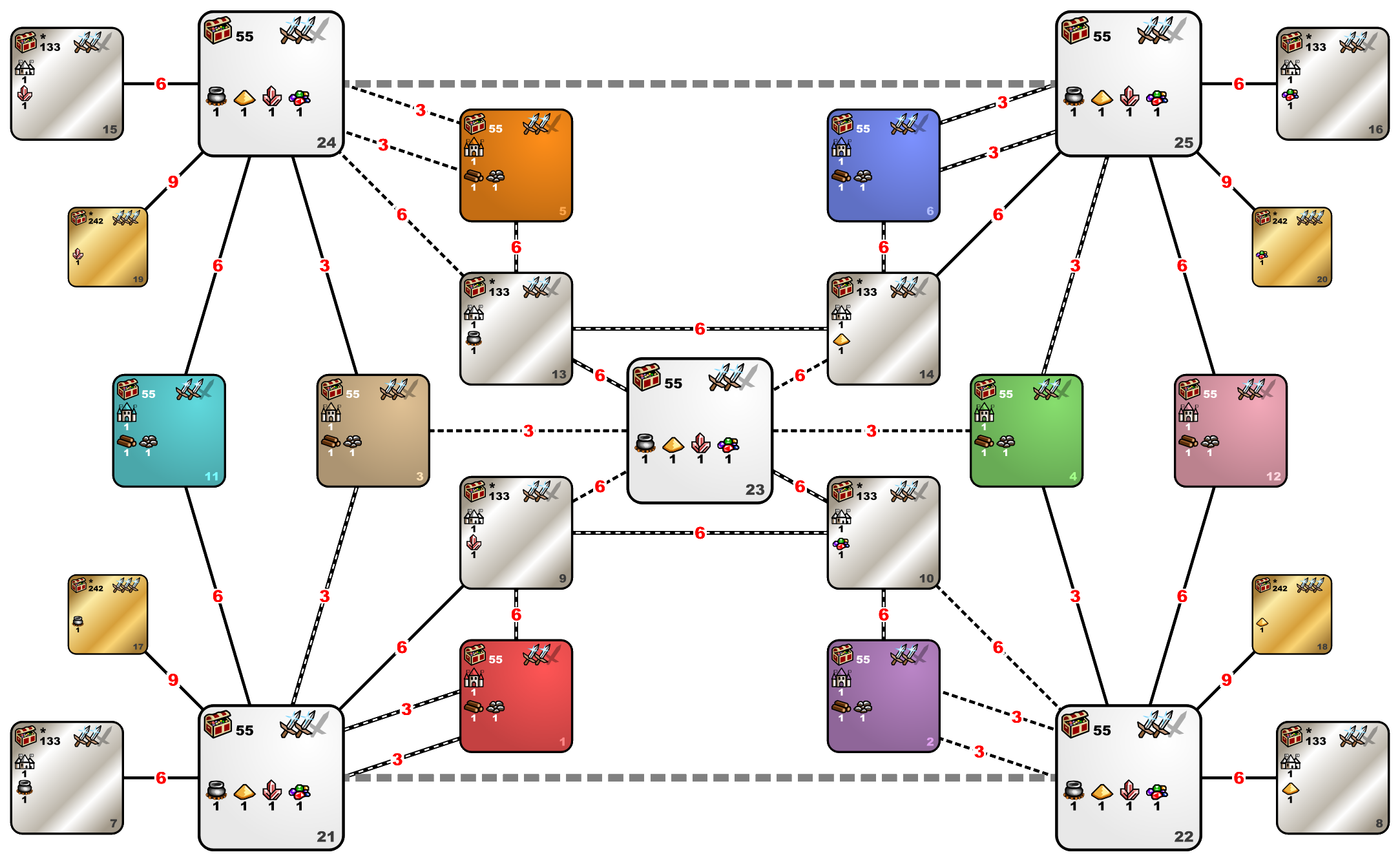
The from the orange (5 and 13) to the red player area (24) as well as from the purple (2 and 10) to the blue player area (22) are disabled. The red has the road ensured from the treasure 10 to the purple (2), while the blue has the road from the treasure 13 to the orange (5). There is an obligatory road through the central zone: 10–23–13.
The purple with the neighboring treasure 10 are included in the red player area of influence, while the orange with the neighboring treasure 13 are included in the blue player area. The road between red and blue players goes through the central zone and both 10 and 13 treasure zones.
Other differences from SoD version:
- Erratic 13–13 connection is removed.
- Connections 15–24 and 16–25 have their value changed from 3000 to 6000 (for the sake of symmetry).
- Wide connections 21–22 and 24–25 are imperatively crossing the land borders.
Suggested rules and settings:
8mm6a
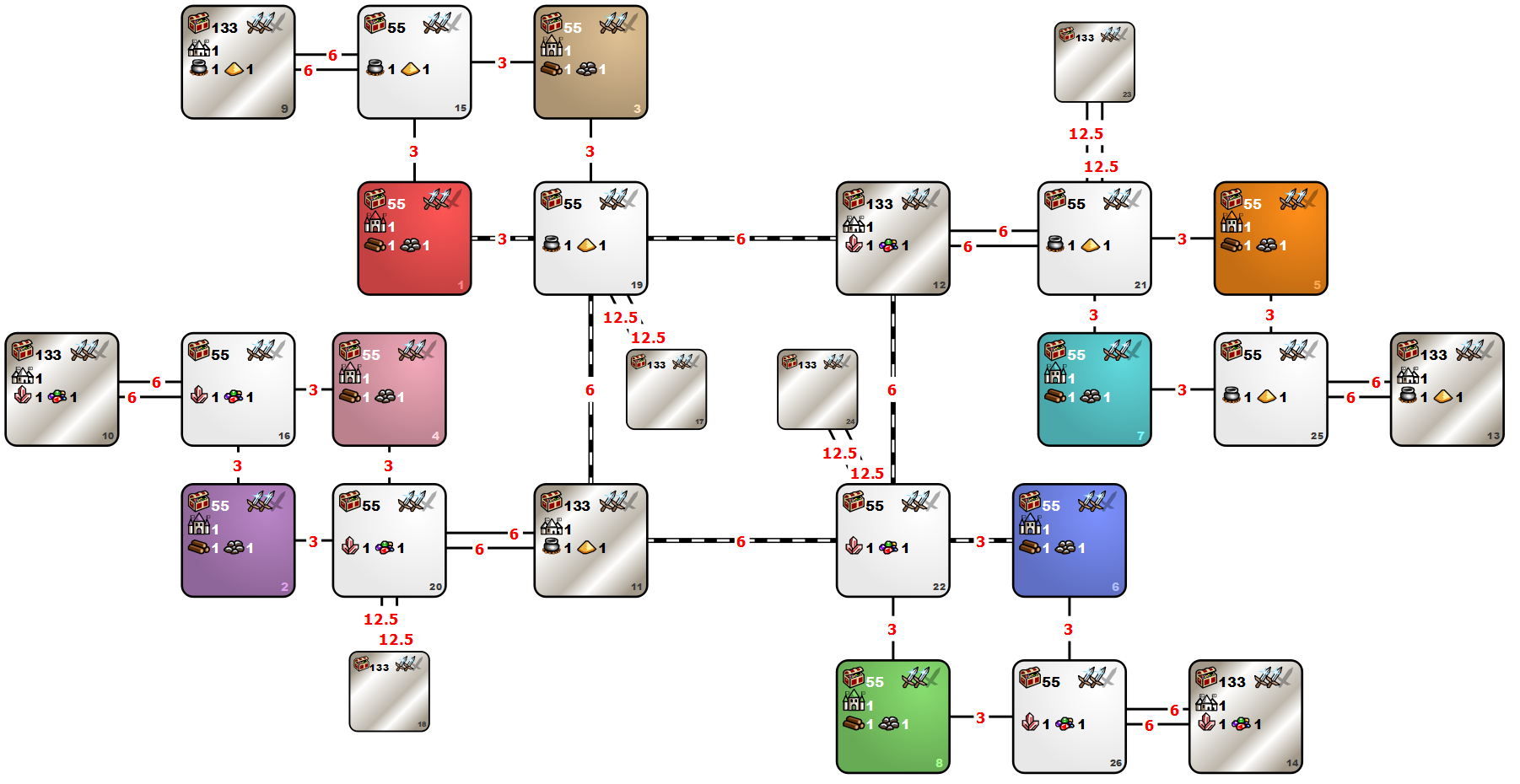
This is the most contact XL+U template. Each player’s accessible area contains AI zone and a corner treasure zone. From their area players may enter one of the 2 central treasure zones, where clash is the most probable. The zones are moderately rich, Relic artifacts cannot be found on their own.
Specifications:
- Map size: XL+U.
- Content types clarification:
- 55 (player zones, AI zones and white zones): content types (500–3000, 9), (3000–6000, 6), (10000–15000, 1).
- 133 (silver zones): content types (3000–6000, 9), (10000–15000, 6), (15000–20000, 1).
- Starting player zones and AI zones have the native terrain of their corresponding town. The rest are generated with random terrain.
- Banned object: Shrine of Magic Mystery.
- Special weeks are disabled.
- Combat round limit is 100.
Differences from SoD version:
- Obligatory roads added: 1–19, 6–22, square 19–12–22–11–19.
Suggested rules and settings:
8xm12a

This is an XL+U template with vast topology and branching road network, where players are considered to explore the territory and research spells. The template has a rich central treasure zone (with Relic artifacts inside) and several poorer treasure zones.
Specifications:
- Map size: XL+U.
- Content types clarification:
- 55 (player zones, AI zones and white zones): content types (500–3000, 9), (3000–6000, 6), (10000–15000, 1).
- 133 (silver zones): content types (3000–6000, 9), (10000–15000, 6), (15000–20000, 1).
- 242 (central gold zone): content types (10000–15000, 9), (15000–20000, 6), (20000–30000, 1).
- Zones with towns have the native terrain of their corresponding town. The rest are generated with random terrain.
- Banned object: Shrine of Magic Mystery.
- Dragon Utopia frequency is increased to 210. Player and AI zones (1–8) and intermediary zones (21–32) may have no more than 1 Dragon Utopia generated. Regular treasure zones (9–20) may have no more than 2 Dragon Utopias generated. Greater treasure zone (33) have no limit on Dragon Utopia number.
- Special weeks are disabled.
- Combat round limit is 100.
Other differences from SoD version:
- Removed all connections 4–15 and 5–14.
- All former paired connections (3–11, 3–14, 4–11, 5–18, 6–15, 6–18) are made single.
- Connections 11–33, 14–33, 15–33, 18–33 (shortcuts to the center zone) are doubled.
- Connections with treasure zones ((3–14, 3–11, 4–11, 6–15, 6–18, 5–18, 26–14, 22–11, 27–15, 31–18, 21–9, 23–10, 25–13, 29–17, 24–12, 28–16, 30–19, 32–20)) have their value changed from 3000 to 6000.
- Obligatory roads added: 12–24–1–21–9, 21–22–3, 22–4 and 20–32–8–29–17, 32–31–6, 31–5 (2 roads per starting zone for red and blue players).
- Some connections were set to imperatively roadless: 11–33, 14–33, 15–33, 18–33 (shortcuts to the center zone) and 4–27, 5–26 (ways to opponent’s computer players).
- The size of intermediary zones (21–32) is decreased from 20 to 15.
- All mines except gold mines are removed from zone 33.
- Crystal and gem mines are added to zones 22 and 33. Mercury and sulfur mines are added to zones 21 and 32.
Suggested rules and settings:
Spider
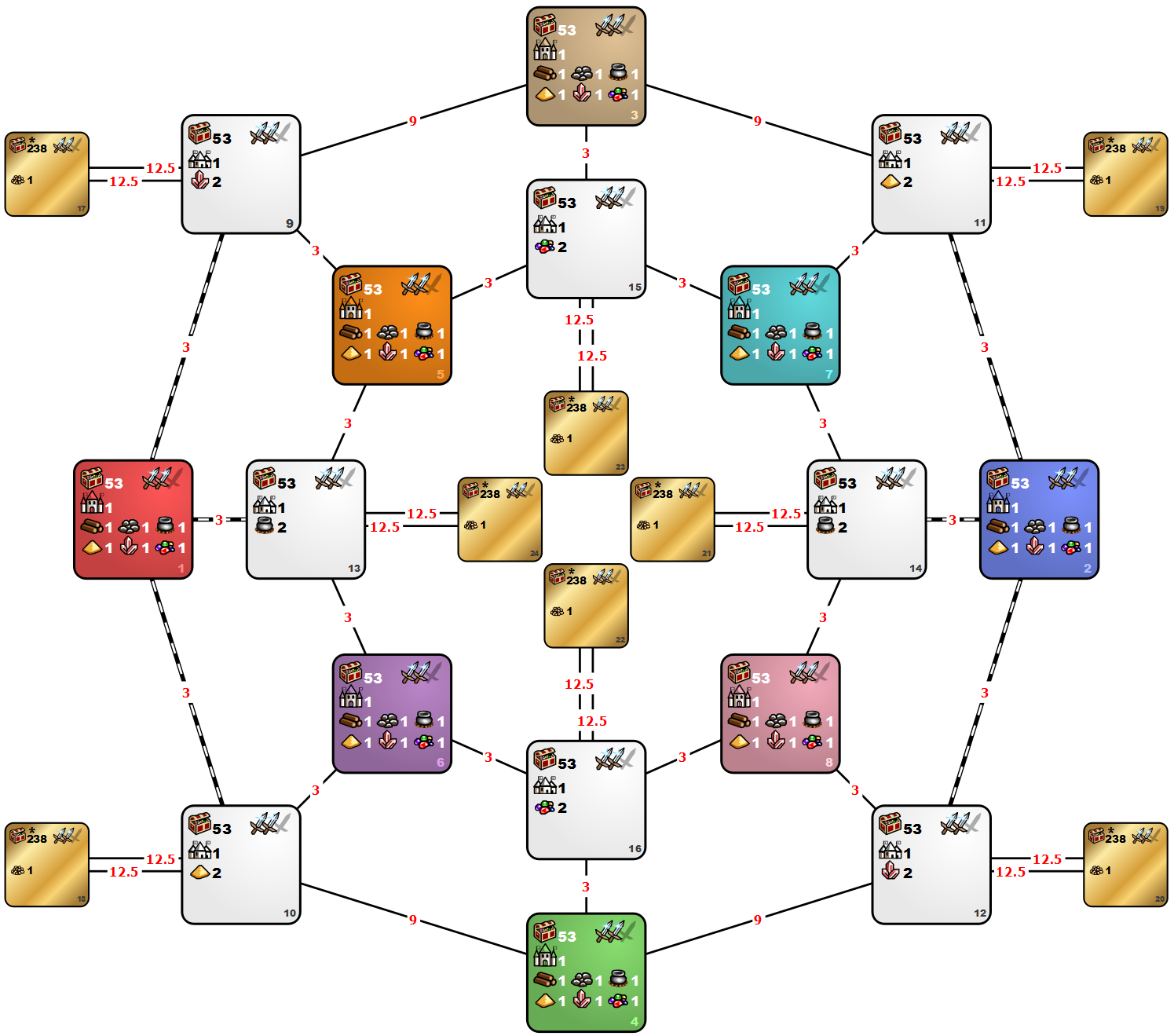
This XL+U template is not so rich. The town number here is above usual, connections are poorly guarded. The players are expected to base their gameplan on exploration and spell research. Treasure zones are quite valuable (though they may not contain Relic artifacts), but they are roadless and quite heavily guarded.
Specifications:
- Map size: XL+U.
- Content types clarification:
- 53 (player zones, AI zones and white zones): content types (100–3000, 9), (3000–6000, 6), (10000–15000, 1).
- 238 (gold zones): content types (6000–8999, 9), (10000–16000, 9), (16000–20000, 3).
- Zones with towns have the native terrain of their corresponding town. The rest are generated with random terrain.
- Banned object: Shrine of Magic Mystery.
- Dragon Utopia frequency in greater treasure zones (17–24) is increased to 200.
- Special weeks are disabled.
- Combat round limit is 100.
Other differences from SoD version:
- Upper range of zones 1–16 content is changed from 6000–9999 to 10000–15000, lesser range is changed from 0–3000 to 100–3000.
- Value of connections 3–9, 3–11, 4–10, 4–12 is changed from 3000 to 9000.
- Obligatory roads added: 1–9, 1–10, 1–13, 2–11, 2–12, 2–14 (3 roads per starting zone for red and blue players).
Suggested rules and settings:
Nostalgia
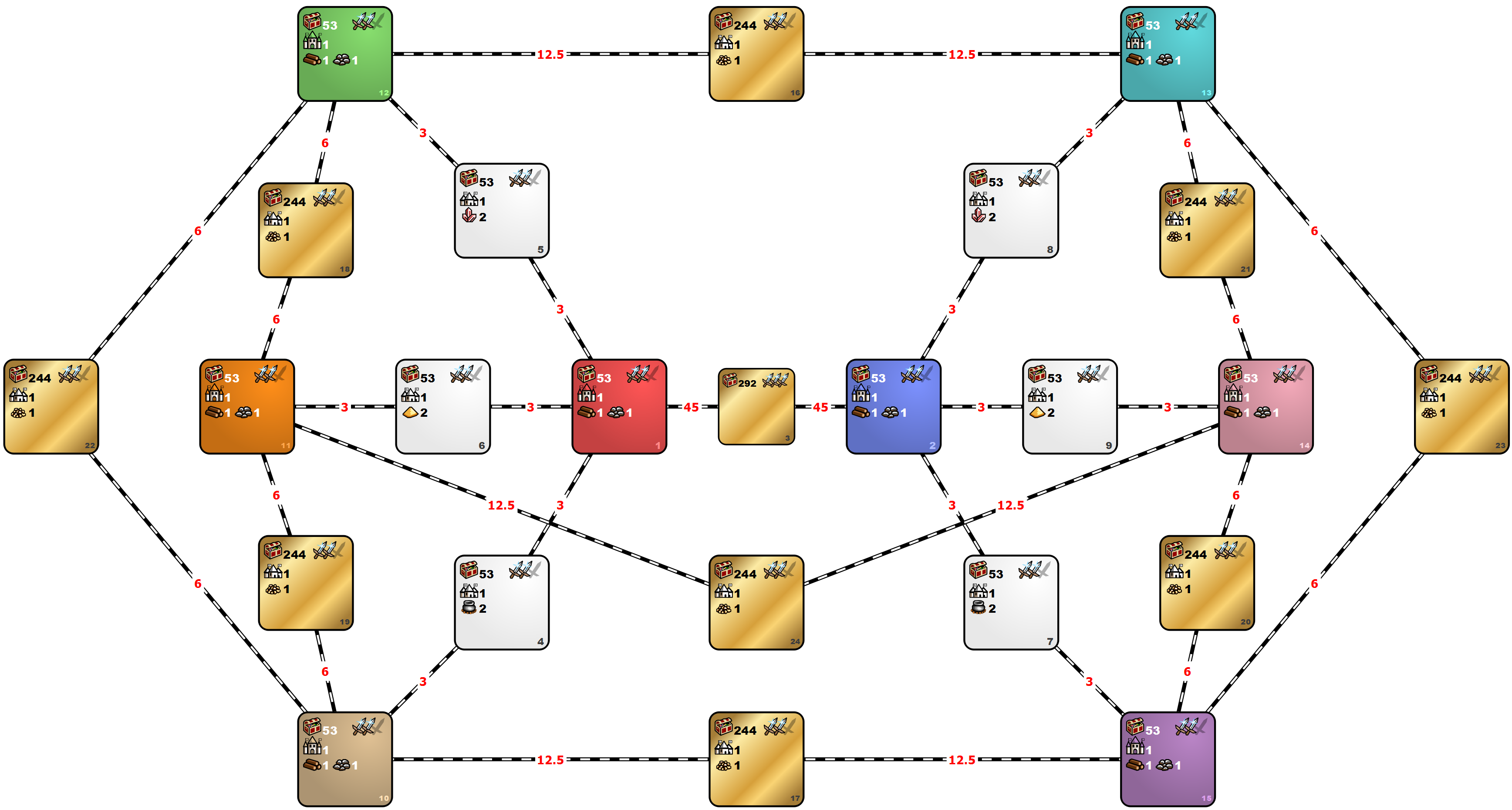
This is a non-contact XL+U template with a simple layout, exploration and spell research-based gameplan is expected. Every player has access to their own half of the map, halves being connected via rare treasure zones. The treasure zones are valuable, but only the central one may have Relics generated. Though this template is non-contact, the tempo is compensated by obligatory roads in each connection.
Specifications:
- Map size: XL+U.
- Content types clarification:
- 53 (player zones, AI zones and white zones): content types (100–3000, 9), (3000–6000, 6), (10000–15000, 1).
- 244 (gold zones): content types (6000–8999, 9), (10000–17000, 9), (17000–20000, 3).
- 292 (central gold zone): content types (10000–15000, 9), (15000–20000, 6), (20000–30000, 3).
- Starting player zones and AI zones have the native terrain of their corresponding town. The rest are generated with random terrain.
- Banned object: Shrine of Magic Mystery.
- Special weeks are disabled.
- Combat round limit is 100.
Other differences from SoD version:
- Lower range of white, player and AI zones content is changed from 0–3000 to 100–3000.
- Value of connections 12–16, 13–16, 10–17, 15–17, 11–24, 14–24 is changed from 6000 to 12500.
- All connections have obligatory roads.
Suggested rules and settings:
Kerberos

This is an XL+U template suitable for three players game (exploration and spell research-based). It consists of a large number of zones. Each player has one AI and a corner treasure zone in their area, from where they can enter the central area, consisting of three regular and 3 rich (potential Relics can be found) treasure zones.
Specifications:
- Map size: XL+U.
- Content types clarification:
- 55 (player zones, AI zones and white zones): content types (500–3000, 9), (3000–6000, 6), (10000–15000, 1).
- 133 (silver zones): content types (3000–6000, 9), (10000–15000, 6), (15000–20000, 1).
- 242 (gold zones): content types (10000–15000, 9), (15000–20000, 6), (20000–30000, 1).
- Starting player zones and AI zones have the native terrain of their corresponding town. The rest are generated with random terrain.
- Different towns of the same zone are forced to have the same alignment.
- Banned heroes: Kyrre, Gunnar, Dessa.
- Banned object: Shrine of Magic Mystery.
- Special weeks are disabled.
- Combat round limit is 100.
Suggested rules and settings:
Clash of Dragons
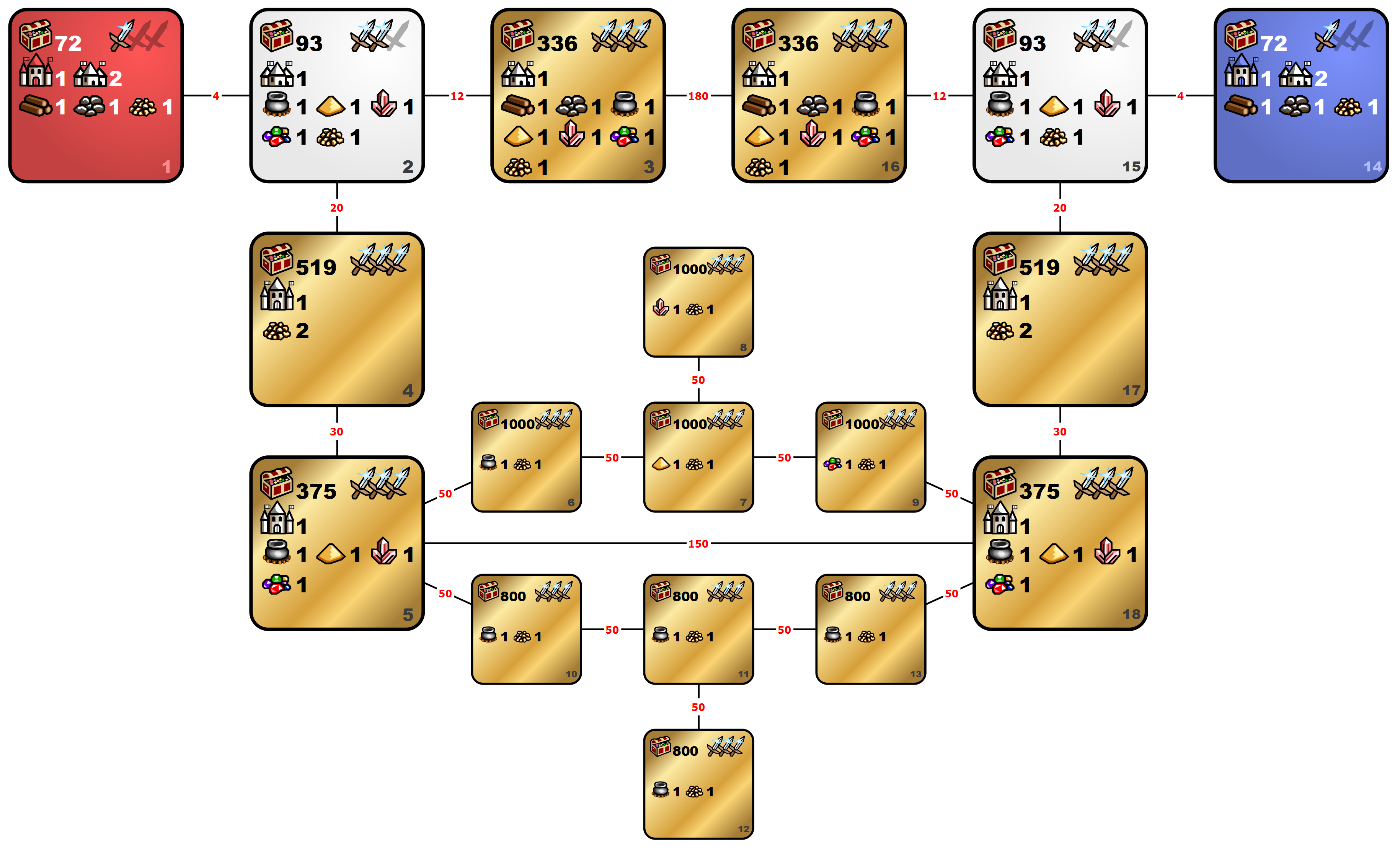
This template is based on the gameplay elements that are usually banned (mechanically or verbally), like Anarchy. The most valuable treasure zones have neutral dragon dwellings, while the gameplan is based on joining the guards in these zones using Diplomacy.
Specifications:
- Map size: XL+U.
- Content types clarification:
- 72 (player zones): content types (300–1900, 15), (2000–5000, 4), (5000–9000, 6).
- 93 (white zones): content types (300–1900, 15), (5000–12000, 2), (10000–20000, 4).
- 336 (upper gold zones): content types (300–1900, 10), (10000–15000, 8), (20000–25000, 10).
- 375 (lower gold zones): content types (20000–30000, 15).
- 519 (indermediary gold zones): content types (300–1900, 6), (10000–15000, 10), (20000–25000, 15).
- 800 (central gold zones, below): content types (80000–80000, 10).
- 1000 (central gold zones, above): content types (80000–120000, 10).
- Starting player zones (1, 14) have the native terrain of their corresponding town. Neighboring zones 2, 15, as well as central zones 6–9 — grass or subterranean. Indermediary zones 4, 17 — dirt or subterranean. Upper Zones 3, 16 — always lava. The rest (5, 18, 10–13) — snow or subterranean.
- Different towns of the same zone are allowed to have different alignments.
- Towns in zones 5, 18 are always Towers.
- Only Rampart, Dungeon and neutral creatures are generated in zones 6–13.
- Zones 6–13 contain only neutral dwellings; Pandora’s Boxes in these zones and Seer Huts requesting artifacts from these zones can have only neutral creatures as rewards.
- Guards can be accepted for free. 100% of group is accepted.
- Allowed artifact assembling: Cloak of the Undead King.
- Anarchy mode is on: SoD shifted guards bug is un-fixed, certain objects can be accessible using Fly or Dimension Door spell without fighting the guards.
- Allowed heroes: Sir Mullich and Galthran; banned heroes: Lord Haart and Ranloo.
- Allowed artifacts: Orb of Inhibition and Recanter’s Cloak.
- Allowed objects: Sanctuary, Cartographer, original Hill Fort; Banned object: HotA Hill Fort.
- Value of Spell Scrolls is reduced: 4th level spells — from 8000 to 4000, 5th level spells — from 10000 to 5000, Fly/Dimension Door/Town Portal — from 20000 to 5000. Maximum amount of these Scrolls is increased from 3/2/1 to 4.
- Special weeks are allowed.
- Combat round limit is 100.
Other differences from SoD version:
- There cannot be more mines in the zone than the number on layout prescribes.
Suggested rules and settings:
Firewalk
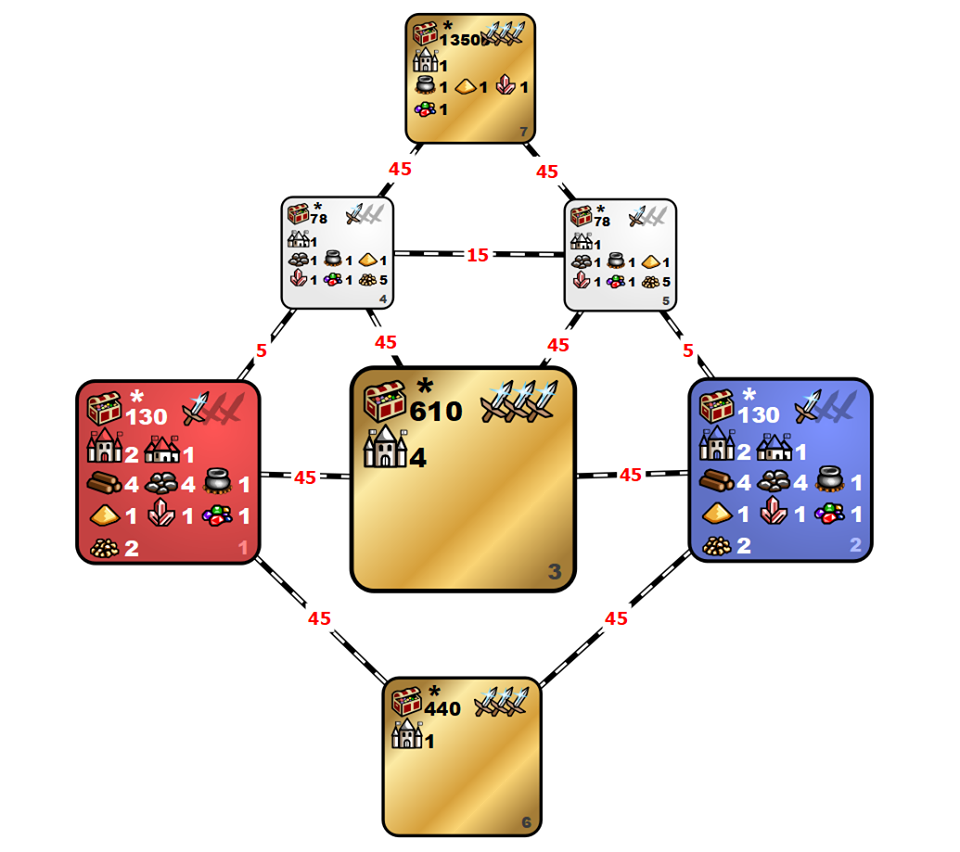
This template has some object setting changed and is focused on dynamic game. Player starting zones contain 3 towns and are very rich, having 1 dwelling of 7th level and 2 dwellings of 6th level. Underground white zones close to players contain Conflux villages, creature banks with gold as well as free piles gold. Players can reach each other through 3 rich treasures: army zone (containing creature objects), dragon utopia zone (containing Dragon Utopias) and big sand zone.
General specifications:
- Map size: XL+U.
- Content types clarification:
- 130 (player and zones): content types (300–3000, 10), (5000–16000, 6), (12000–22000, 3).
- 79 (white zones): content types (750–3000, 5), (3500–3500, 20).
- 610 (gold big sand zone): content types (10000–25000, 10), (25000–35000, 10), (35000–55000, 3).
- 320 (gold army zone): content types (7900–8100, 40).
- 9160 (gold dragon utopia zone): content types (8000–8000, 20), (45000–45000, 100), (45000–45000, 100).
- Zones 4, 5 and 7 are always located on the underground layer on subterranean terrain. The rest are located on surface layer. Starting player zones (1 and 2) have the native terrain of their corresponding town. Big sand zone 3 is generated on sand, and army zone 6 is generated on lava.
- Monsters disposition is forced to Savage (10), they won’t join neither for free, nor for gold.
- Towns in zones 4 and 5 always have Conflux type.
- Allowed artifacts: Orb of Inhibition and Recanter’s Cloak.
- Special weeks are disabled.
- Combat round limit is 100.
Suggested rules and settings:
Custom object generation rules:
Note: object generation settings are separated into 4 categories:
1. Banned objects doesn’t appear in the specified zone.
2. Allowed with default settings. This means that these objects are generated in certain zone similarly to any generic template. Neither object nor guard settings are changed.
3. Allowed with custom limits. These objects have almost the same settings as by default, but the maximum amount of them is limited. E.g., Churchyard with maximum of 1 per zone will have the same settings as on generic template, but there cannot be more than 1 Churchyard in this zone.
4. Allowed with custom frequency and/or value. In case the value is changed, this may affect the power of the monsters guarding this object — this is the most notable kind of change that can be applied to object generation settings, especially for more skilled players, who had already got used to default values. Frequency change may affect the number of objects of this type in a given zone, but, unlike changing the limits, this change is not so strict.Object bans and permissions apply in the order of appearance on the list. I.e., some global bans may be overridden by further permissions (e.g., banning all dwellings, then allowing 1 level dwellings will cause only level 1 dwellings to generate). This principle applies both on general template settings and on specifications for each zone.
Zones 1 and 2. Red and blue player zones.
Creature objects: Griffin Conservatory, Dragon Fly Hive, Experimental Shop, Wolf Rider Picket, Red Tower
Dragon Utopia
Random relic artifact
Spell scroll level 4 and 5 (including Fly / Dimension Door / Town Portal)
Warrior’s Tomb
Refugee Camp
Prison
Quest artifacts for Seer’s Hut
Pandora’s Box with creatures
Pandora’s Box with spells
Pandora’s Box with gold
Ranged level 1–3 creature generators: Archers’s Tower, Homestead, Workshop, Hall of Sins, Pillars of Eyes, Orc Tower, Lizard Den, Altar of Air, Altar of Water, Frigate, Halflings’ Hut.
Allowed with custom zone limits:
Creature generators of level 1–5 (except banned ones), max per zone: 2
Mercenary Camp, max per zone: 5
Marletto Tower, max per zone: 5
Star Axis, max per zone: 5
Garden of Revelation, max per zone: 5
School of War, max per zone: 5
School of Magic, max per zone: 5
Arena, max per zone: 3
Colloseum of the Magi, max per zone: 3
Library of Enlightenment, max per zone: 1
Allowed with custom value/frequency/limits:
Creature generators of level 6, frequency: 1000, max per zone: 2
Creature generators of level 7, frequency: 1000, max per zone: 1
Pandora’s Box with 5000 experience, frequency: 100
Pandora’s Box with 10000 experience, frequency: 50
Zone 3. Gold big sand zone.
Creature objects: Griffin Conservatory, Dragon Fly Hive, Experimental Shop, Wolf Rider Picket, Red Tower
Creature generators
Dragon Utopia
Creature banks with gold: Imp Cache, Dwarven Treasury, Medusa Stores, Naga Bank, Mansion
Treasure chest
Gold (random resource is allowed)
Pandora’s Box with spells from specific levels (Pandora’s Boxes with all spells from certain School are allowed)
Prison
Allowed with custom zone limits:
Prison (hero with 0 exp), max per zone: 6
Library of Enlightenment, max per zone: 5
Zones 4 and 5. White underground zones.
All objects are banned. Allowed objects are listed below individually.
Allowed with default settings:
Treasure Chest
Resource piles: wood, mercury, ore, sulfur, crystals, gems, gold, random resource
Allowed with custom zone limits:
Churchyard, max per zone: 5
Allowed with custom value/frequency/limits:
Imp Cache, value: 3500, frequency: 10000, max per zone: 8
Dwarven Treasure, value: 3500, frequency: 10000, max per zone: 8
Naga Bank, value: 3500, frequency: 10000, max per zone: 8
Zone 6. Gold army zone on lava.
All objects are banned. Allowed objects are listed below individually.
Allowed with default settings:
Resource piles: wood, mercury, ore, sulfur, crystals, gems, random resource (no separate gold)
Allowed with custom value/frequency/limits:
Griffin Conservatory, value: 8000, frequency: 100, max per zone: 4
Dragon Fly Hive, value: 8000, frequency: 100, max per zone: 6
Experimental Shop, value: 8000, frequency: 100, max per zone: 4
Wolf Rider Picket, value: 8000, frequency: 100, max per zone: 6
Red Tower, value: 8000, frequency: 100, max per zone: 4
Zone 7. Gold underground dragon utopia zone.
All objects are banned. Allowed objects are listed below individually.
Allowed with default settings:
Resource piles: wood, mercury, ore, sulfur, crystals, gems, random resource (no separate gold)
Allowed with custom value/frequency/limits:
Dragon Utopia, value: 45000, frequency: 10000, max per zone: 8
XL-U templates
Jebus Cross

One of the most popular templates overall, due to its simple layout and fast pace. Every player starts on a big, poorly guarded and rich zone with the native terrain. From the starting zone they may enter the extra-rich central zone. To do so, they must defeat strong passage guards. Once got into the central zone, the player starts to accumulate power rapidly, that’s why it’s crucial to get there as soon as possible (even on the first week). This template is not considered well-balanced, because the outcome depends greatly on the starting zones contents.
Specifications:
- Map size: XL-U or L-U.
- Content types clarification:
- 103 (player zones): content types (300–3000, 14), (5000–16000, 6), (12000–22000, 1).
- 610 (central gold zone): content types (10000–25000, 10), (25000–35000, 10), (35000–55000, 3).
- Zones 2–5 have the native terrain of their corresponding town. Zone 1 is always sand.
- Different towns of the same zone are allowed to have different alignments.
- Zones 2–5 are set up symmetrically around the central zone 1.
- Maximum amount of Taverns, Mineral Springs and Hermit’s Shacks per zone is increased to 3.
- Ancient Lamps are enabled in zones 1–4.
- Special weeks are disabled.
- Combat round limit is 100.
Other differences from SoD version:
- There cannot be more mines in the zone than the number on layout prescribes.
- All town and guard alignments are allowed.
Suggested rules and settings:
L+U templates
2sm4d(3)
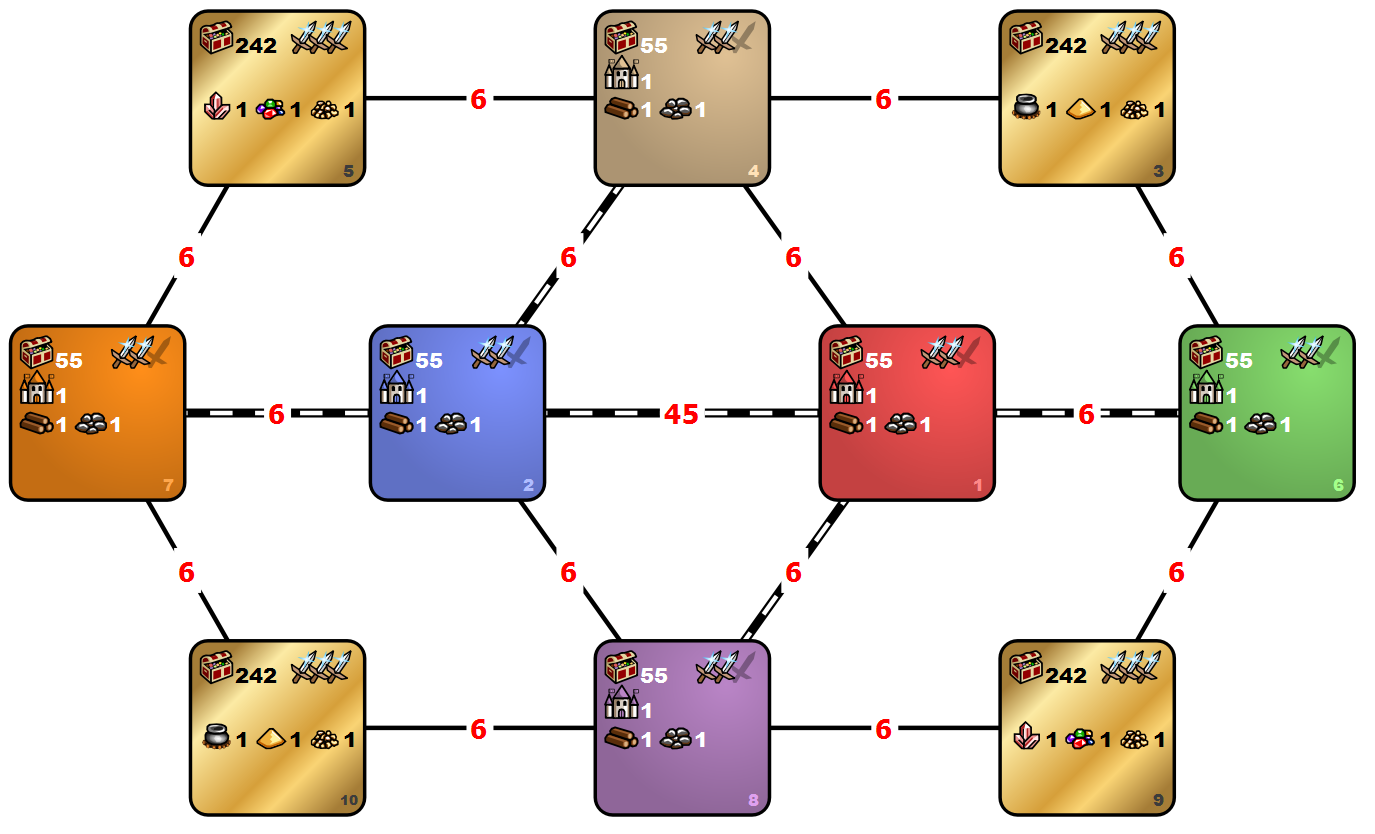
Once popular, this template is now replaced by the others. The treasure zones on it may have valuable objects (like Relics), but connections leading there are imperatively roadless. The template allows a high variation of gameplay, the early contact in adjacent zones is as possible as exploration game or opponent zone rush. Even though the AI players are depicted on the layout, usually they are disabled, and their towns are rendered neutral.
Specifications:
- Map size: L+U.
- Content types clarification:
- 55 (player zones and AI zones): content types (500–3000, 9), (3000–6000, 6), (10000–15000, 1).
- 242 (gold zones): content types (10000–15000, 9), (15000–20000, 6), (20000–30000, 1).
- All zones with towns have the native terrain of their corresponding town. The rest are generated with random terrain.
- Banned object: Shrine of Magic Mystery.
- Special weeks are disabled.
- Combat round limit is 100.
Differences from SoD version:
- There cannot be more mines and towns in the zone than the number on layout prescribes.
- Fixed road network: connections 1–2, 1–6, 1–8, 2–4, 2–7 have obligatory roads, the rest are imperatively roadless.
Suggested rules and settings:
Mini-Nostalgia
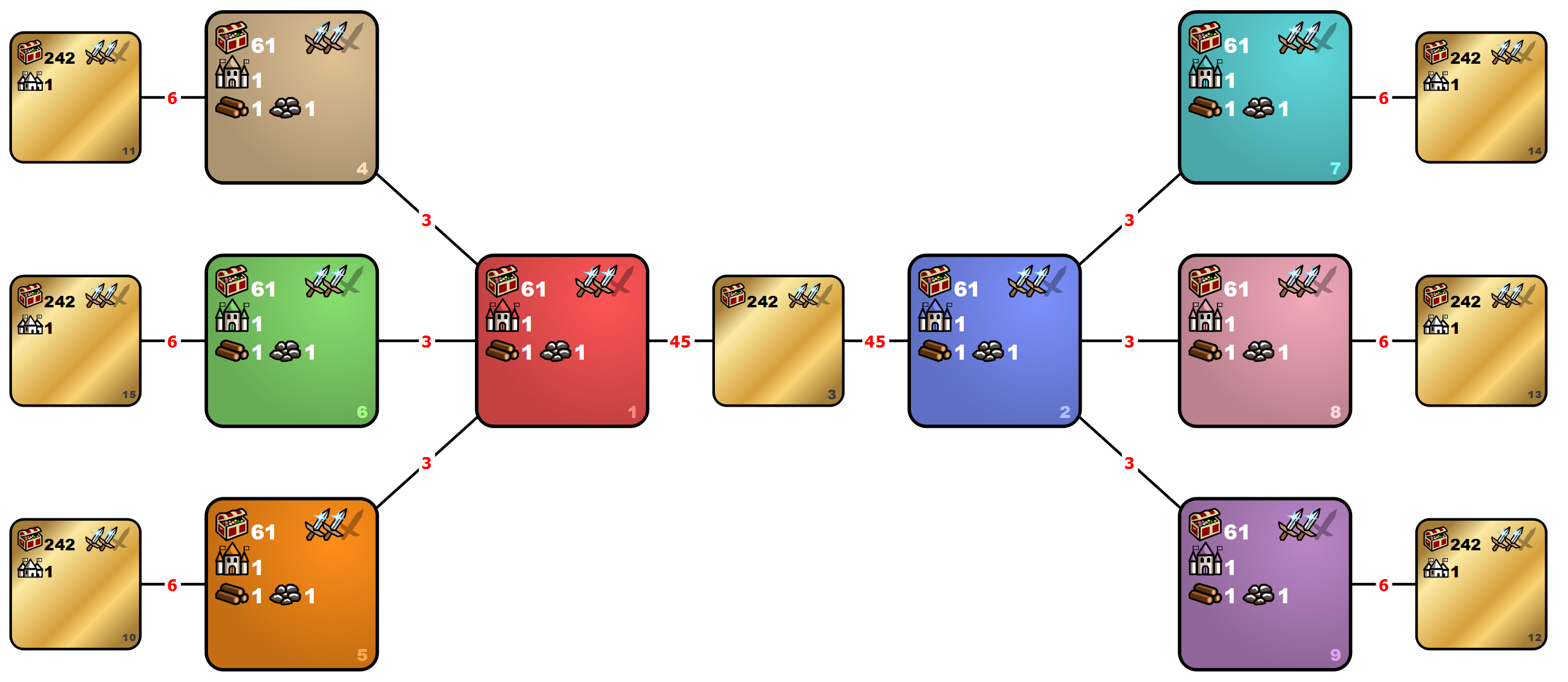
On this template players never make an early contact between themselves, but since the first days they fight their corresponding AI. 3 lightly guarded passages lead from AI zones to rich, but usually small treasure zones with a chance of getting a Relic. Player zones are connected via even richer treasure zone, connections heavily guarded.
Specifications:
- Map size: L+U.
- Content types clarification:
- 61 (player zones and AI zones): content types (100–3000, 14), (3000–6000, 6), (10000–15000, 1).
- 242 (gold zones): content types (10000–15000, 9), (15000–20000, 6), (20000–30000, 1).
- Starting player zones and AI zones have the native terrain of their corresponding town. The rest are generated with random terrain.
- Banned object: Shrine of Magic Mystery.
- Dragon Utopia frequency is increased to 200. Player and AI zones (1–2, 4–9) may have no more than 1 Dragon Utopia generated. Greater treasure zones (3, 10–15) have no limit on Dragon Utopia number.
- Special weeks are disabled.
- Combat round limit is 100.
Differences from SoD version:
- Lower content value range is changed from 0–3000 to 100–3000.
Suggested rules and settings:
Diamond
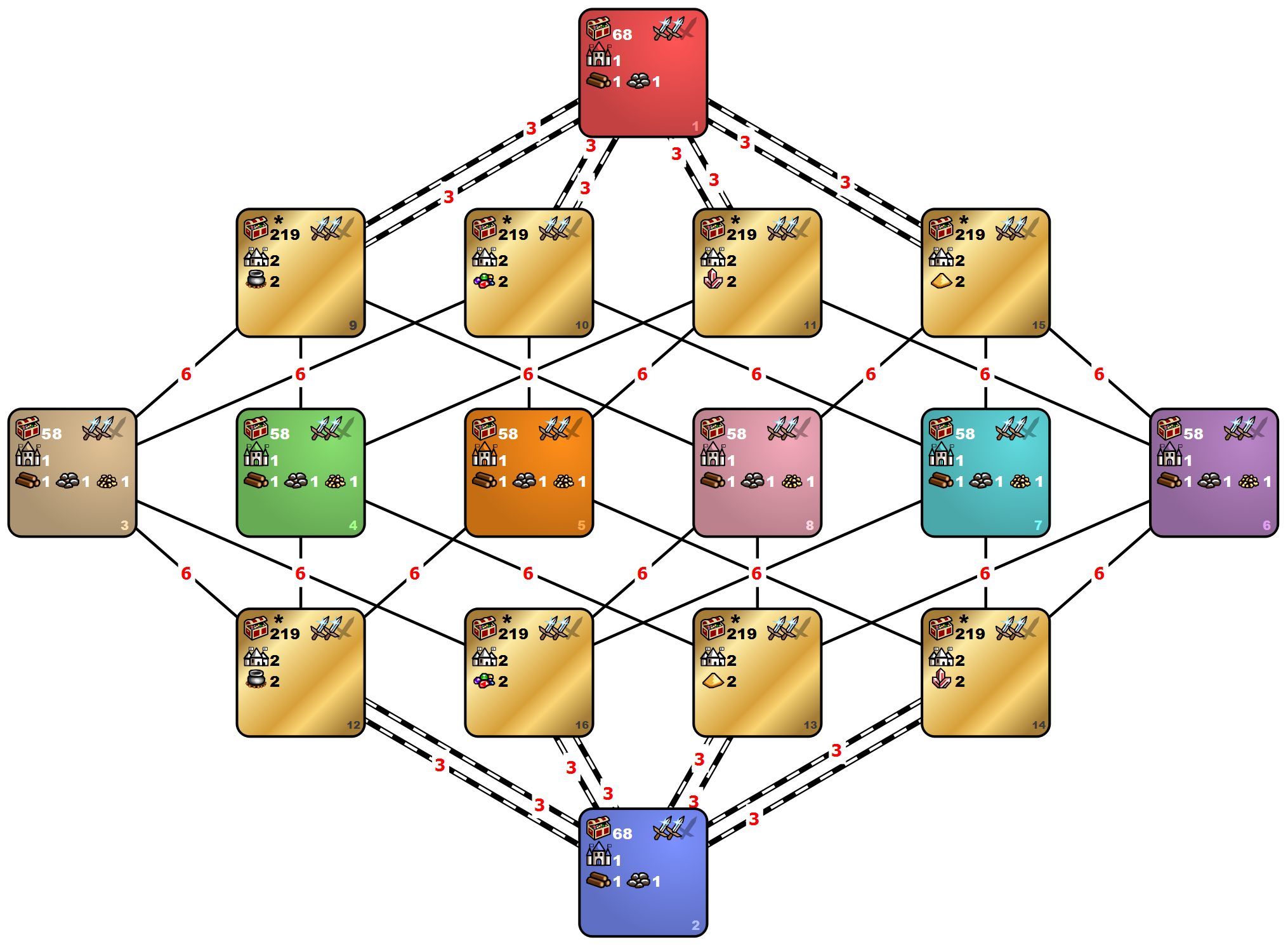
This is a rich and variative template. Every player has 4 lightly guarded passages to treasure zones, and players’ treasure zones are separated by AI zones. Treasure zones may have unguarded small treasures, like piles of gold, but also thу most valuable rewards, like Relics. The template has a lot of villages on it, and the road network allows quite a lot of variation in gameplay, from early contact to suspended endgame.
Specifications:
- Map size: L+U.
- Content types clarification:
- 68 (player zones): content types (100–3000, 12), (3000–6000, 6), (6000–8999, 3).
- 58 (AI zones): content types (100–3000, 12), (3000–6000, 6), (10000–15000, 1).
- 219 (gold zones): content types (100–3000, 9), (9000–20000, 9), (20000–30000, 3).
- Starting player zones and AI zones have the native terrain of their corresponding town. The rest are generated with random terrain.
- Different towns of the same zone are allowed to have different alignments.
- Non-coherent road networks are allowed inside all zones.
- Banned object: Shrine of Magic Mystery.
- Dragon Utopia frequency is increased to 200. Player and AI zones (1–8) may have no more than 1 Dragon Utopia generated. Greater treasure zones (9–16) have no limit on Dragon Utopia number.
- Special weeks are disabled.
- Combat round limit is 100.
Other differences from SoD version:
- Lower content value range is changed from 0–3000 to 100–3000.
- Obligatory roads added: 1–9, 1–10, 1–11, 1–15 and 2–12, 2–13, 2–14, 2–16 (4 roads per starting zone for red and blue players).
Suggested rules and settings:
Boomerang
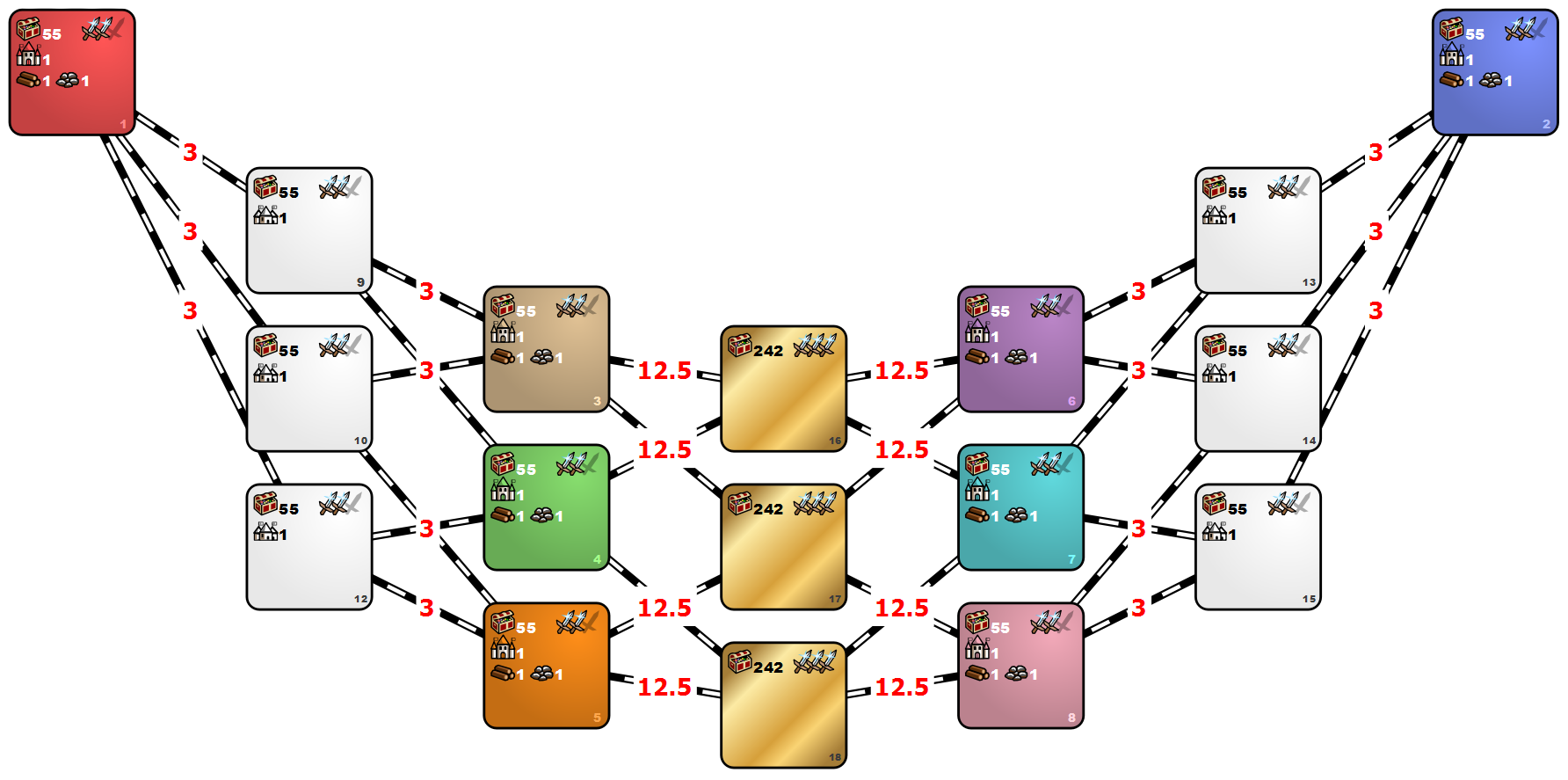
The template consisting of a large number of zones with default contents and several rich central treasure zones (Relic generation is possible).
Specifications:
- Map size: L+U.
- Content types clarification:
- 55 (player zones, AI zones and white zones): content types (500–3000, 9), (3000–6000, 6), (10000–15000, 1).
- 242 (gold zones): content types (10000–15000, 9), (15000–20000, 6), (20000–30000, 1).
- Starting player zones and AI zones have the native terrain of their corresponding town. The rest are generated with random terrain.
- Banned object: Shrine of Magic Mystery.
- Special weeks are disabled.
- Combat round limit is 100.
Suggested rules and settings:
Apocalypse
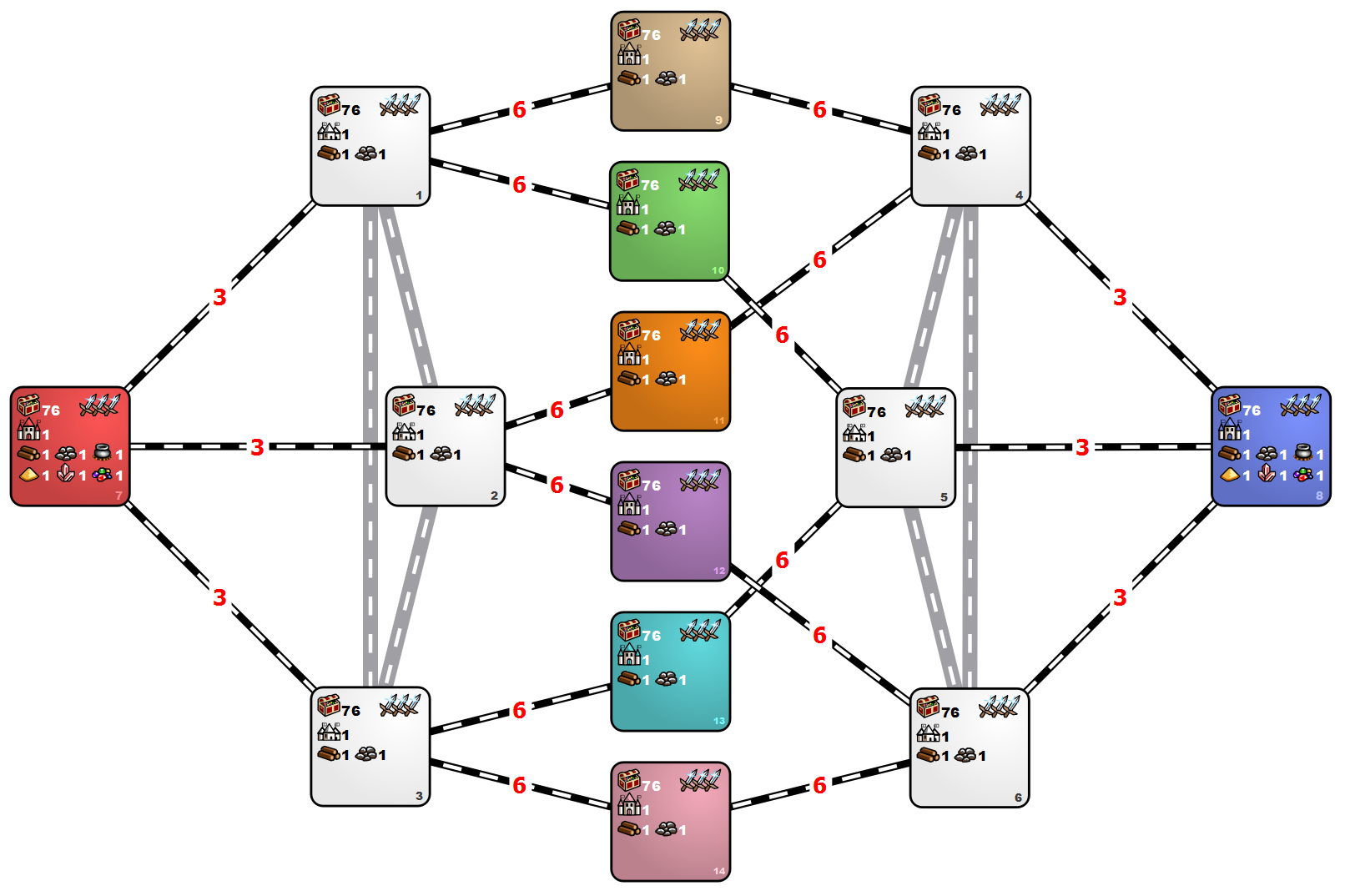
Quite poor treasure-wise template, where the players start in underground level, and the surface consists of two large sand zones, separated by AI zones. In-zone guards are enhanced. There are no treasure zones whatsoever, but all zones have higher frequency of valuable objects. The template shows 3 sand zones per player, but, as they are connected with wide connections, 6 zones effectively turn into 2.
Specifications:
- Map size: L+U.
- Content types clarification:
- 76 (player zones, AI zones and white zones): content types (100–3000, 9), (3000–6000, 6), (9000–15000, 3).
- Starting player zones and AI zones are always located on the underground layer and have subterranean terrain. The rest are on the surface and have sand terrain.
- Players and AI cannot select Necropolis as starting alignment. All neutral tows are Necropoles.
- All Necropolis heroes are banned.
- Banned artifacts: Amulet of the Undertaker, Vampire’s Cowl, Dead Man’s Boots, Wayfarer’s Boots.
- Banned objects: Shrine of Magic Mystery, Dragon Utopia, Skeleton Transformer.
- Special weeks are disabled.
- Combat round limit is 100.
Suggested rules and settings:
Anarchy
This template’s gameplay is based on the gameplay elements that are usually banned (mechanically or verbally): Cloak of the Undead King, joining guards by Diplomacy, Cartographer, poorly guarded spell scrolls, abusing misplaced guards. One template of 12 is randomly selected each generation, and the player has to guess each time.
General specifications:
- Map size: L+U.
- Starting player zones have the native terrain of their corresponding town. The rest are generated with random terrain.
- Guards can be accepted for free. 100% of group is accepted.
- Allowed artifact assembling: Cloak of the Undead King.
- Anarchy mode is on: SoD shifted guards bug is un-fixed, certain objects can be accessible using Fly or Dimension Door spell without fighting the guards.
- Allowed heroes: Sir Mullich and Galthran; banned heroes: Lord Haart and Ranloo.
- Allowed artifacts: Orb of Inhibition and Recanter’s Cloak.
- Allowed objects: Sanctuary, Cartographer, original Hill Fort; Banned object: HotA Hill Fort.
- Value of Spell Scrolls is reduced: 4th level spells — from 8000 to 4000, 5th level spells — from 10000 to 5000, Fly/Dimension Door/Town Portal — from 20000 to 5000. Maximum amount of these Scrolls is increased from 3/2/1 to 4.
- Special weeks are allowed.
- Combat round limit is 100.
Differences from SoD version:
- Lower content value range is changed from 0–3000 to 100–3000 on all templates of the pack.
- Connection 10–12 on the 6th template has the value changed from 12500 to 6000 (for the sake of symmetry).
Suggested rules and settings:
Particular templates layouts and specifications:
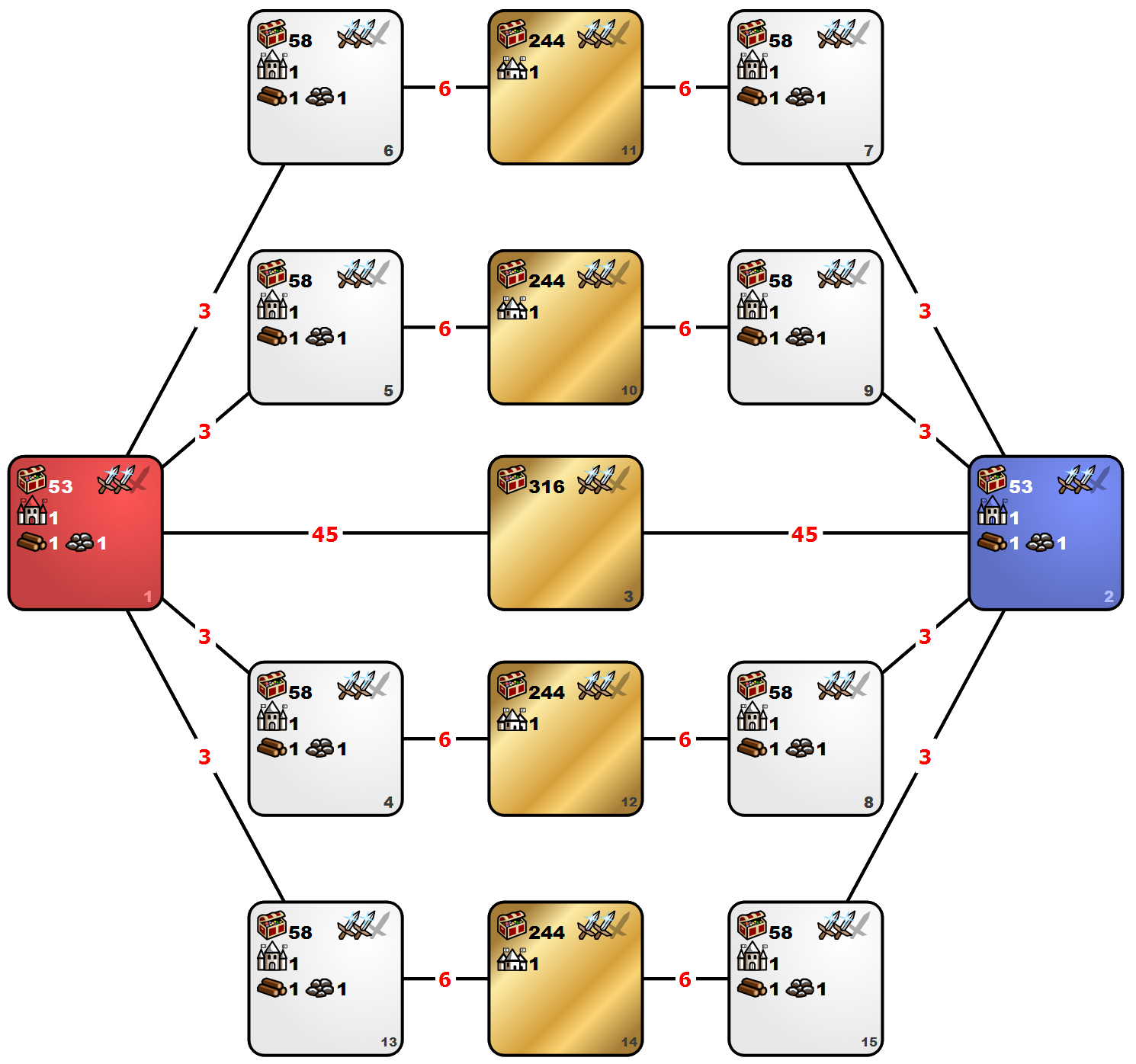
Specifications:
- Content types clarification:
- 53 (player zones): content types (100–3000, 12), (3000–6000, 6), (6000–8999, 1).
- 58 (white zones): content types (100–3000, 12), (3000–12000, 6), (10000–15000, 1).
- 244 (gold zones): content types (6000–8999, 9), (10000–17000, 9), (17000–20000, 3).
- 316 (central gold zone): content types (10000–17000, 9), (17000–22000, 6), (22000–30000, 3).
AnarchyN2

Specifications:
- Content types clarification:
- 53 (player zones): content types (100–3000, 12), (3000–6000, 6), (6000–8999, 1).
- 58 (white zones): content types (100–3000, 12), (3000–12000, 6), (10000–15000, 1).
- 244 (gold zones): content types (6000–8999, 9), (10000–17000, 9), (17000–20000, 3).
AnarchyN3
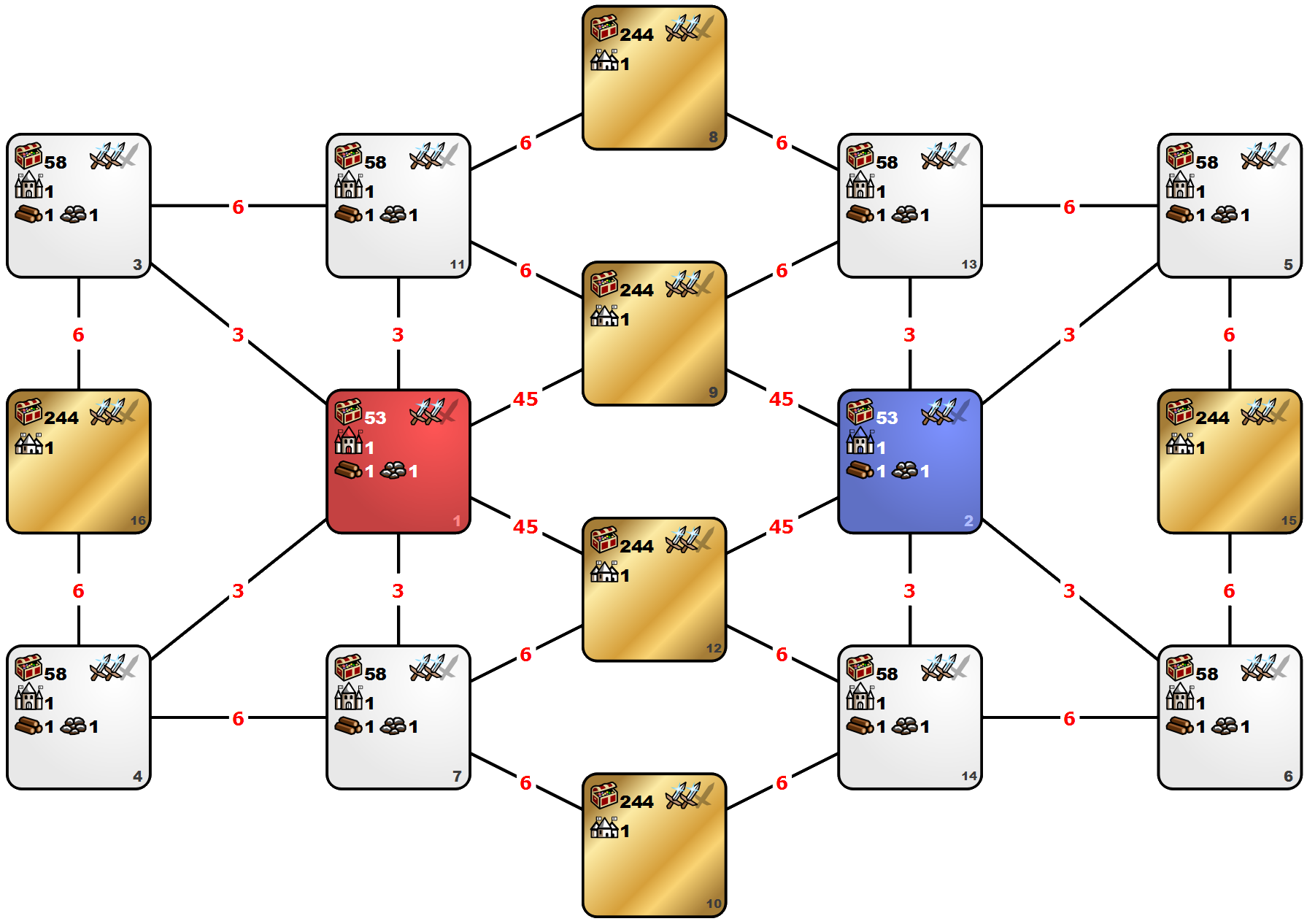
Specifications:
- Content types clarification:
- 53 (player zones): content types (100–3000, 12), (3000–6000, 6), (6000–8999, 1).
- 58 (white zones): content types (100–3000, 12), (3000–12000, 6), (10000–15000, 1).
- 244 (gold zones): content types (6000–8999, 9), (10000–17000, 9), (17000–20000, 3).
AnarchyN4
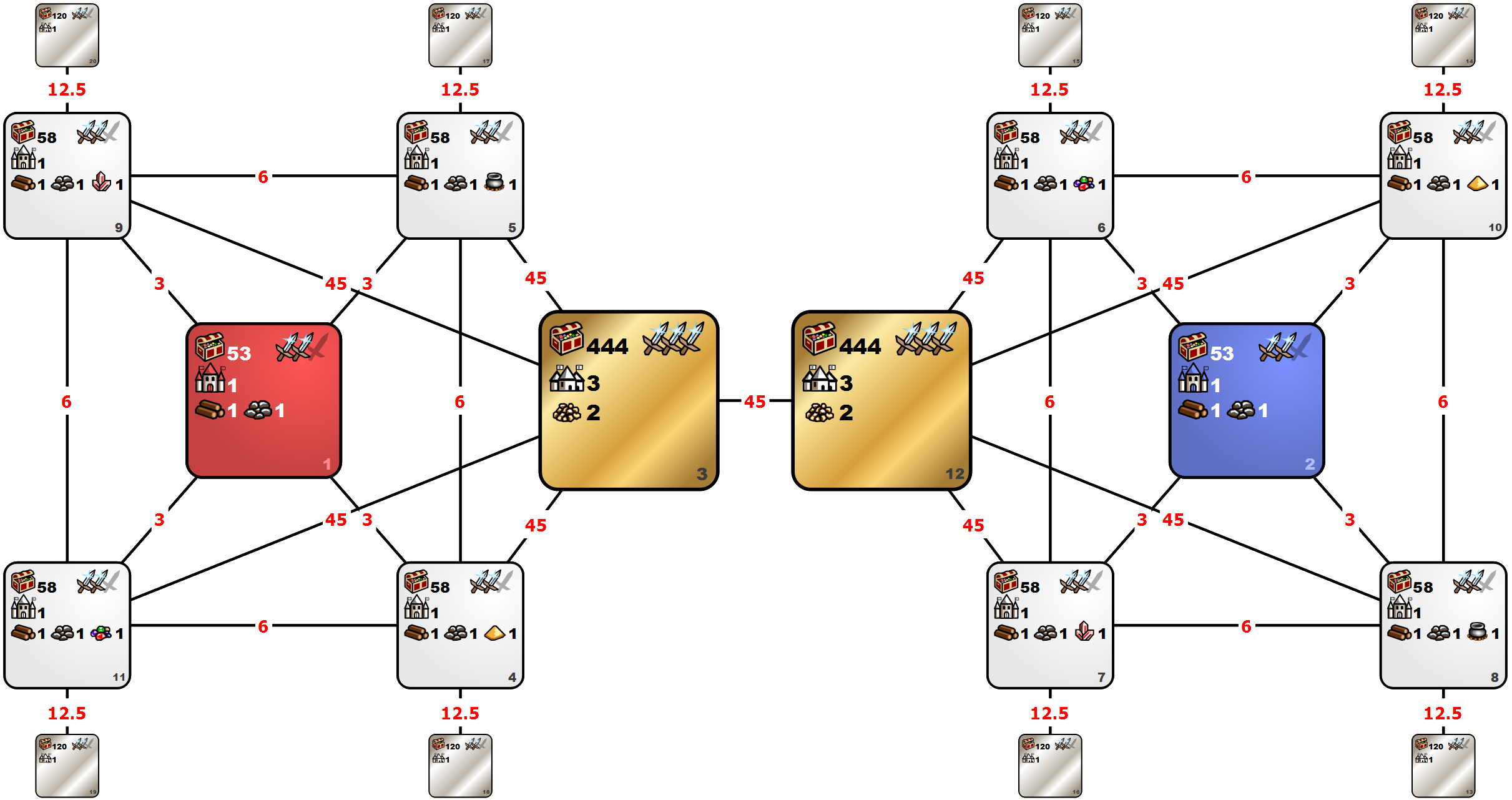
Specifications:
- Different towns of the same zone are allowed to have different alignments.
- Content types clarification:
- 53 (player zones): content types (100–3000, 12), (3000–6000, 6), (6000–8999, 1).
- 58 (white zones): content types (100–3000, 12), (3000–12000, 6), (10000–15000, 1).
- 120 (silver zones): content types (9000–11000, 12).
- 444 (gold zones): content types (10000–17000, 9), (15000–30000, 9), (30000–50000, 3).
AnarchyN5

Specifications:
- Different towns of the same zone are allowed to have different alignments, unless they are player zones. Otherwise all the towns in the zone must have the same alignment.
- Content types clarification:
- 119 (player zones): content types (100–3000, 12), (3000–6000, 9), (9000–11000, 6).
- 58 (white zones): content types (100–3000, 12), (3000–12000, 6), (10000–15000, 1).
- 183 (silver zones): content types (5000–8000, 9), (8000–11000, 9), (11000–15000, 3).
- 352 (gold zones): content types (9000–15000, 9), (15000–22000, 9), (22000–30000, 3).
AnarchyN6
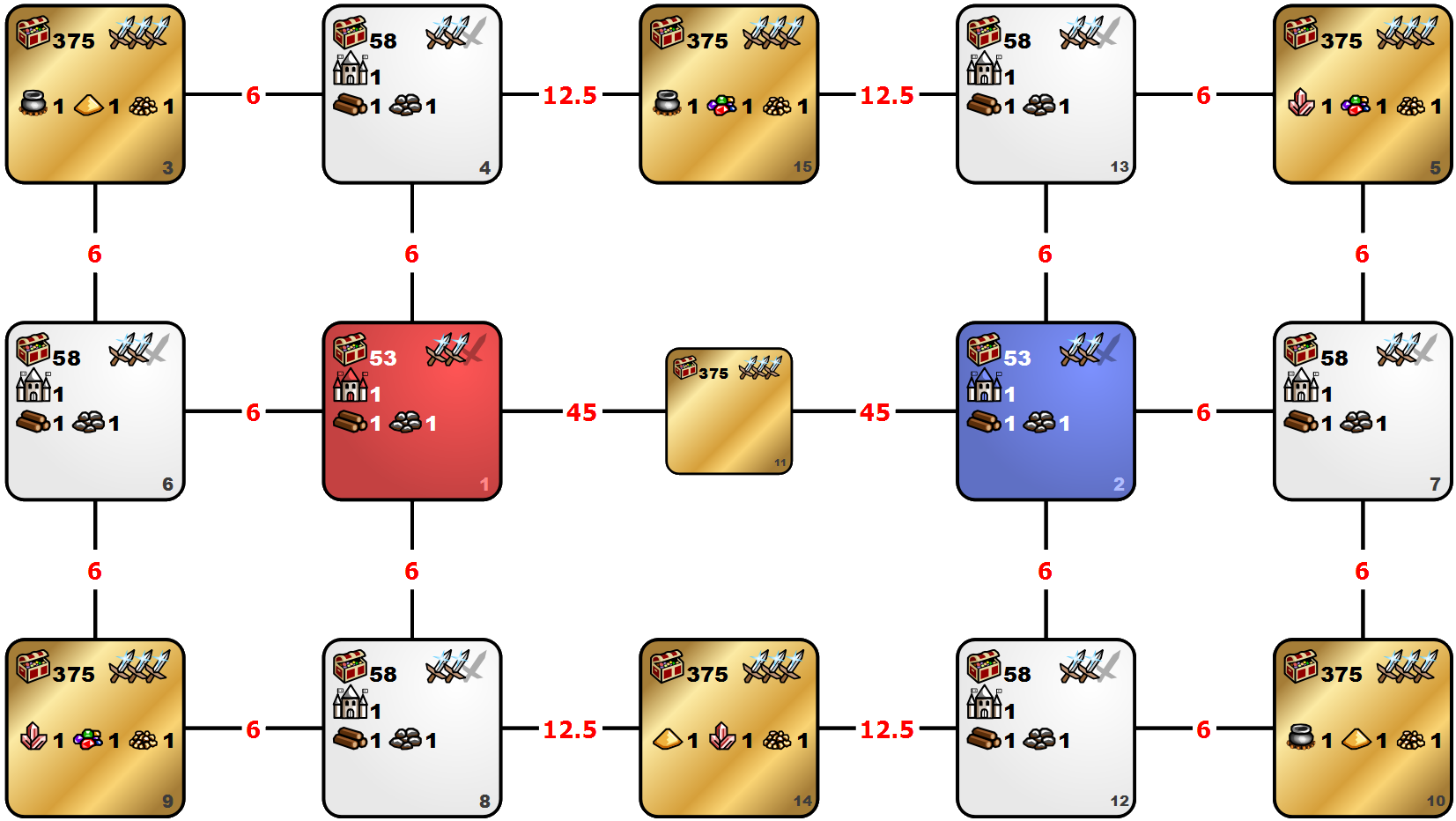
Specifications:
- Content types clarification:
- 53 (player zones): content types (100–3000, 12), (3000–6000, 6), (6000–8999, 1).
- 58 (white zones): content types (100–3000, 12), (3000–12000, 6), (10000–15000, 1).
- 375 (gold zones): content types (10000–17000, 9), (17000–22000, 9), (22000–30000, 3).
AnarchyN7
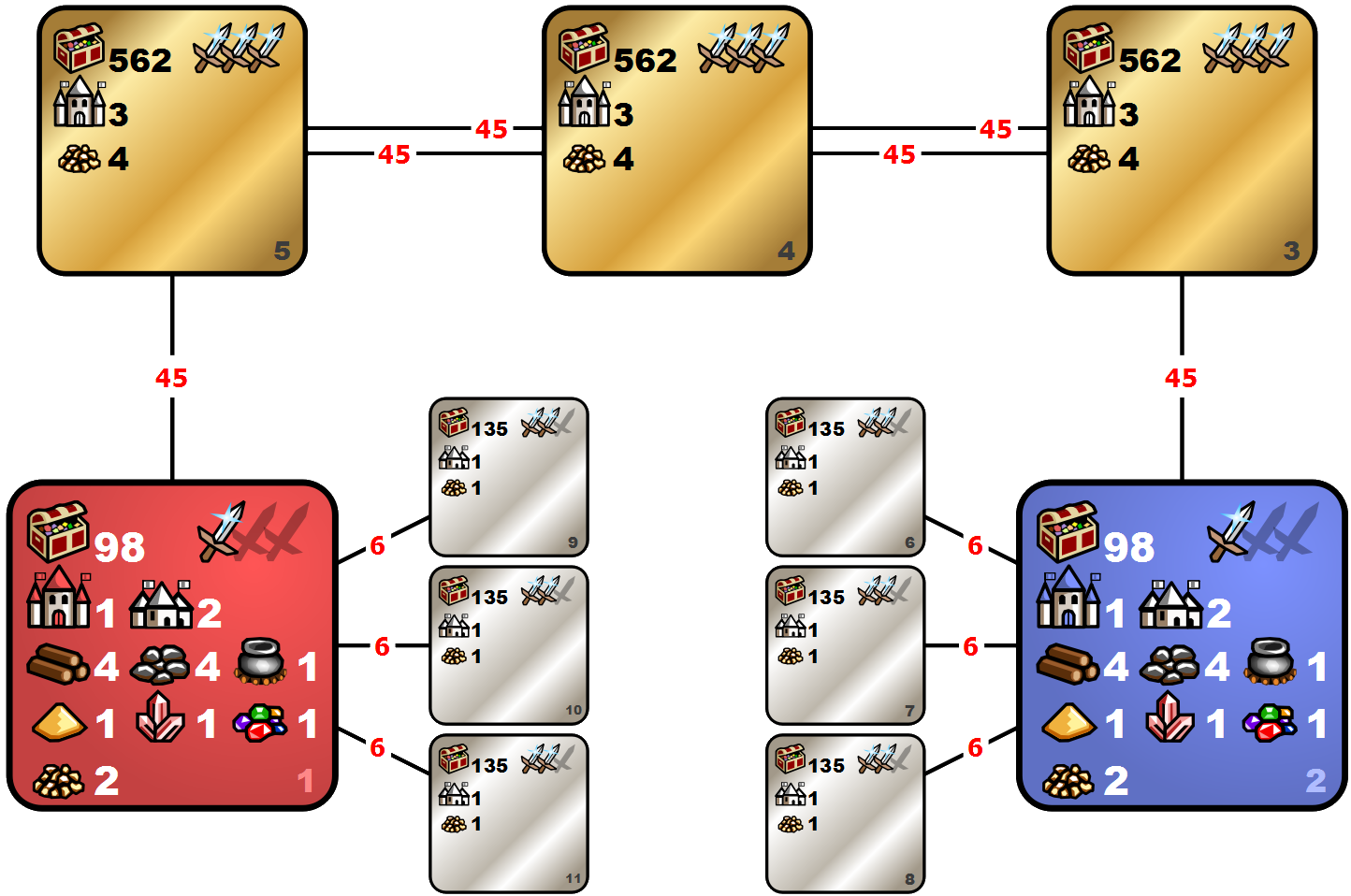
Specifications:
- Different towns of the same zone are allowed to have different alignments, unless they are player zones. Otherwise all the towns in the zone must have the same alignment.
- Content types clarification:
- 98 (player zones): content types (100–3000, 12), (5000–16000, 6), (12000–22000, 1).
- 135 (silver zones): content types (5000–8000, 6), (8000–11000, 6), (11000–15000, 3).
- 562 (gold zones): content types (10000–25000, 9), (25000–35000, 9), (35000–55000, 3).
AnarchyN8
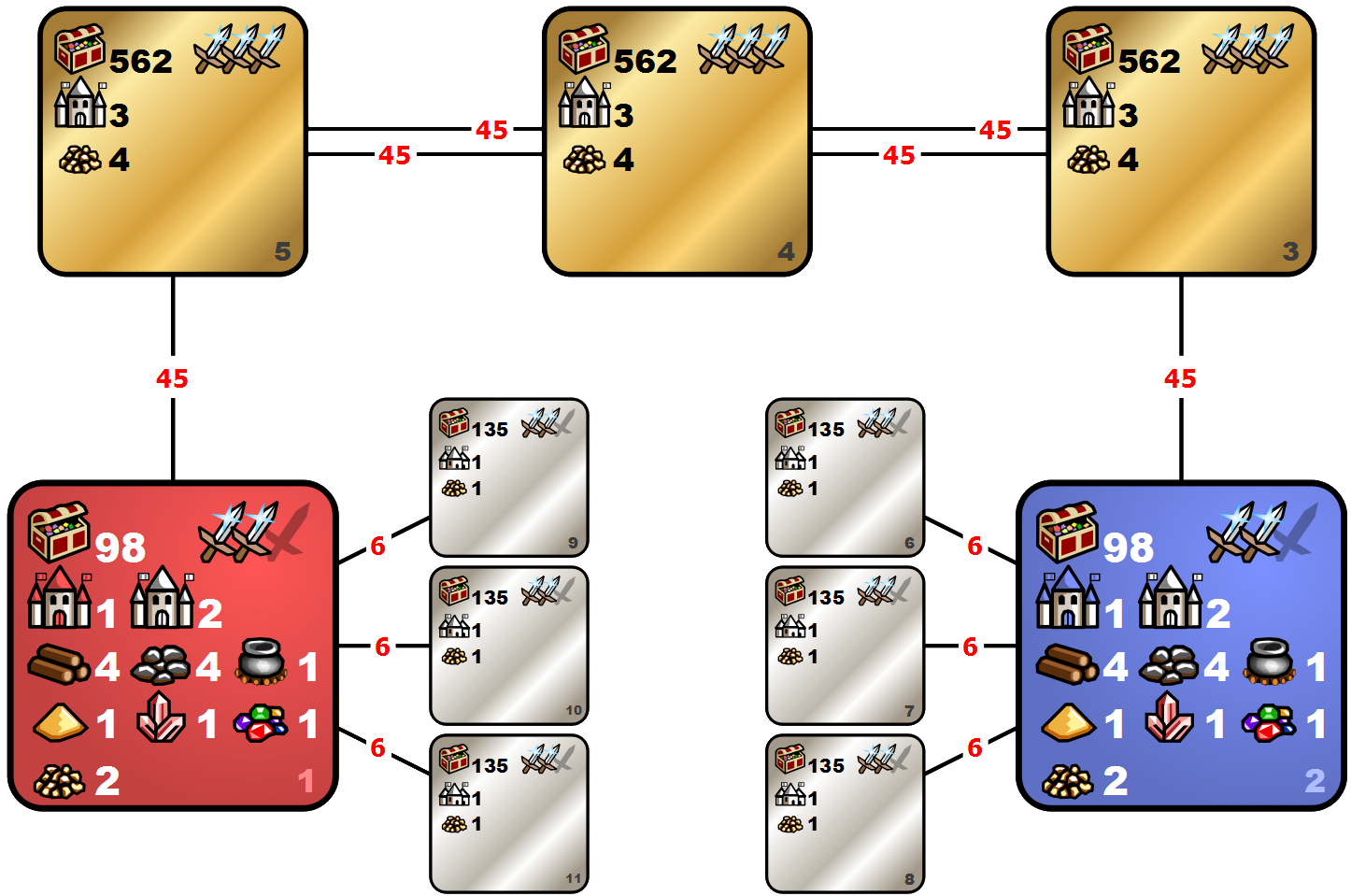
Specifications:
- Different towns of the same zone are allowed to have different alignments, unless they are player zones. Otherwise all the towns in the zone must have the same alignment.
- Content types clarification:
- 98 (player zones): content types (100–3000, 12), (5000–16000, 6), (12000–22000, 1).
- 135 (silver zones): content types (5000–8000, 6), (8000–11000, 6), (11000–15000, 3).
- 562 (gold zones): content types (10000–25000, 9), (25000–35000, 9), (35000–55000, 3).
AnarchyN9
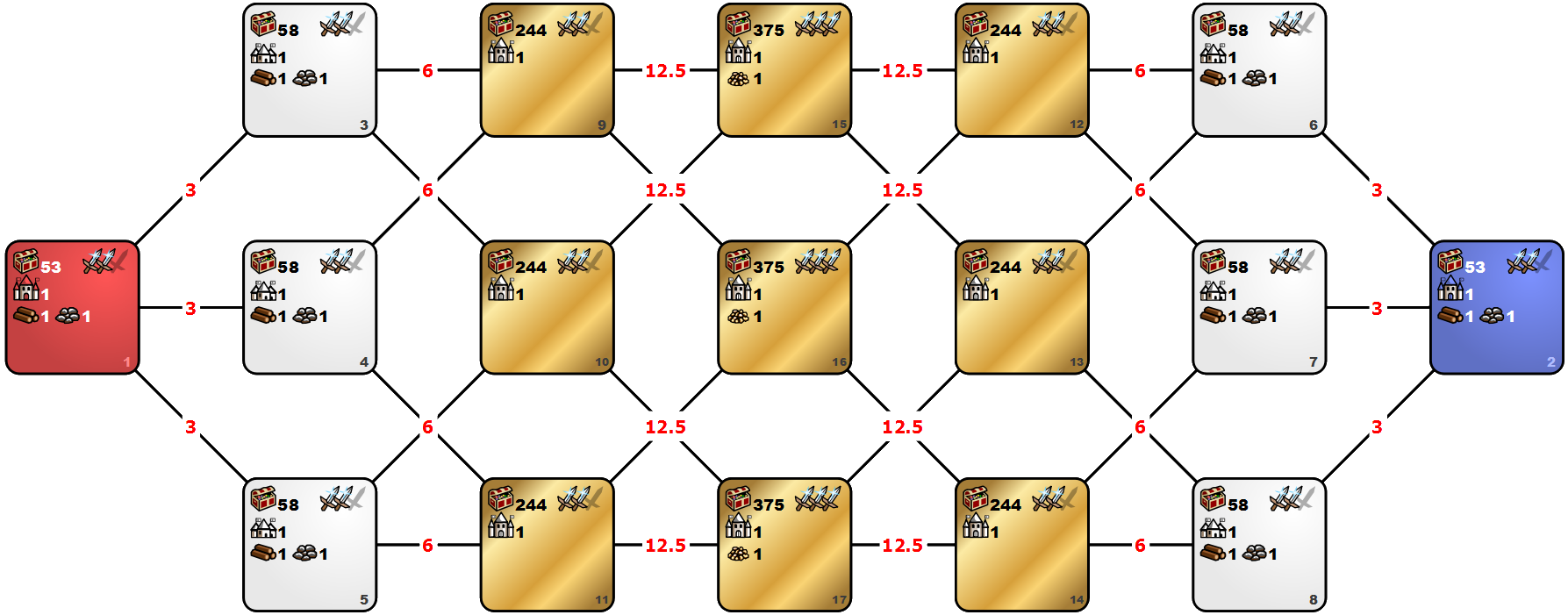
Specifications:
- Content types clarification:
- 53 (player zones): content types (100–3000, 12), (3000–6000, 6), (6000–8999, 1).
- 58 (white zones): content types (100–3000, 12), (3000–12000, 6), (10000–15000, 1).
- 244 (gold zones): content types (6000–8999, 9), (10000–17000, 9), (17000–20000, 3).
AnarchyN10
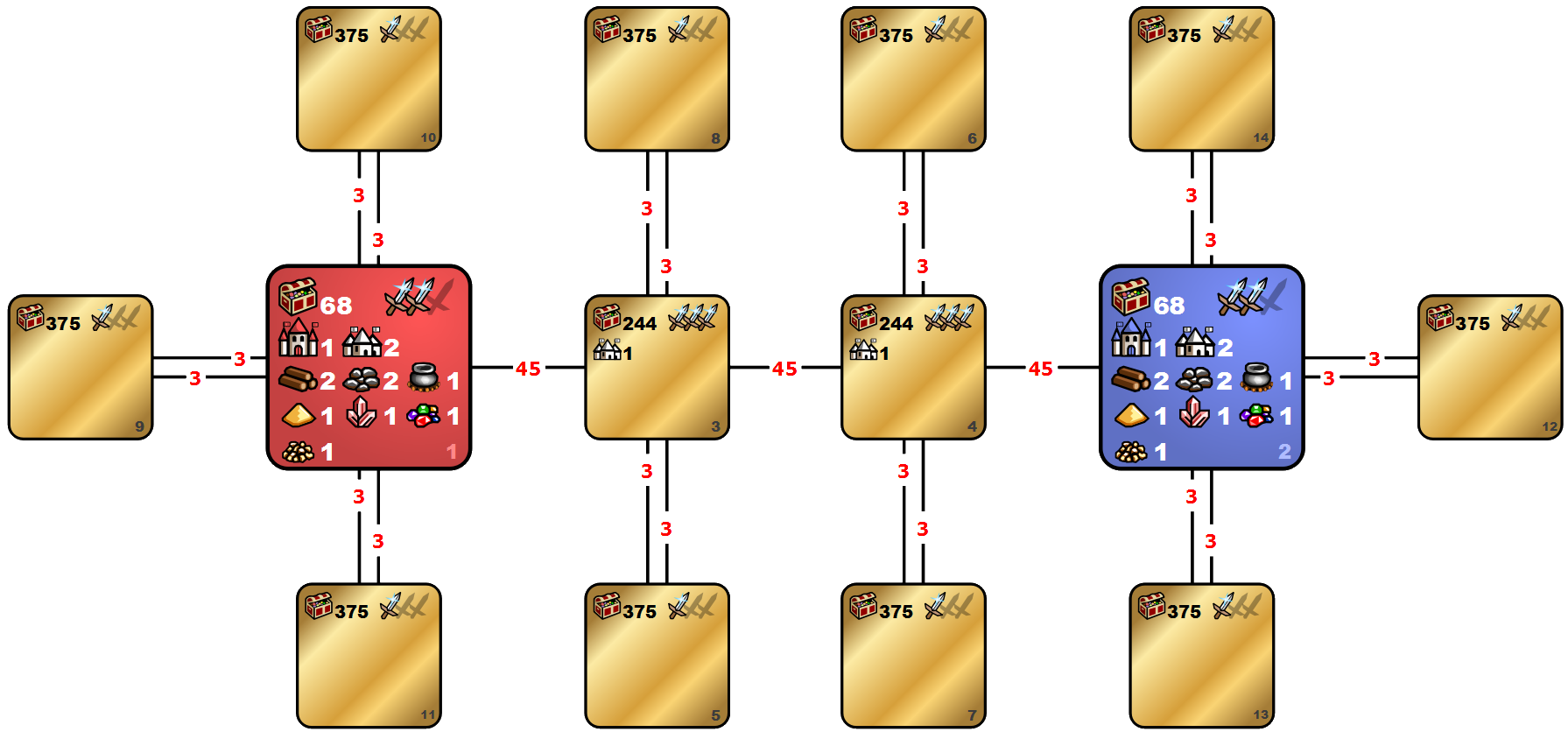
Specifications:
- All the towns in the zone must have the same alignment.
- Content types clarification:
- 68 (player zones): content types (100–3000, 12), (3000–6000, 6), (6000–8999, 3).
- 244 (central gold zones): content types (6000–8999, 9), (10000–17000, 9), (17000–20000, 3).
- 375 (border gold zones): content types (10000–17000, 9), (17000–22000, 9), (22000–30000, 3).
AnarchyN11
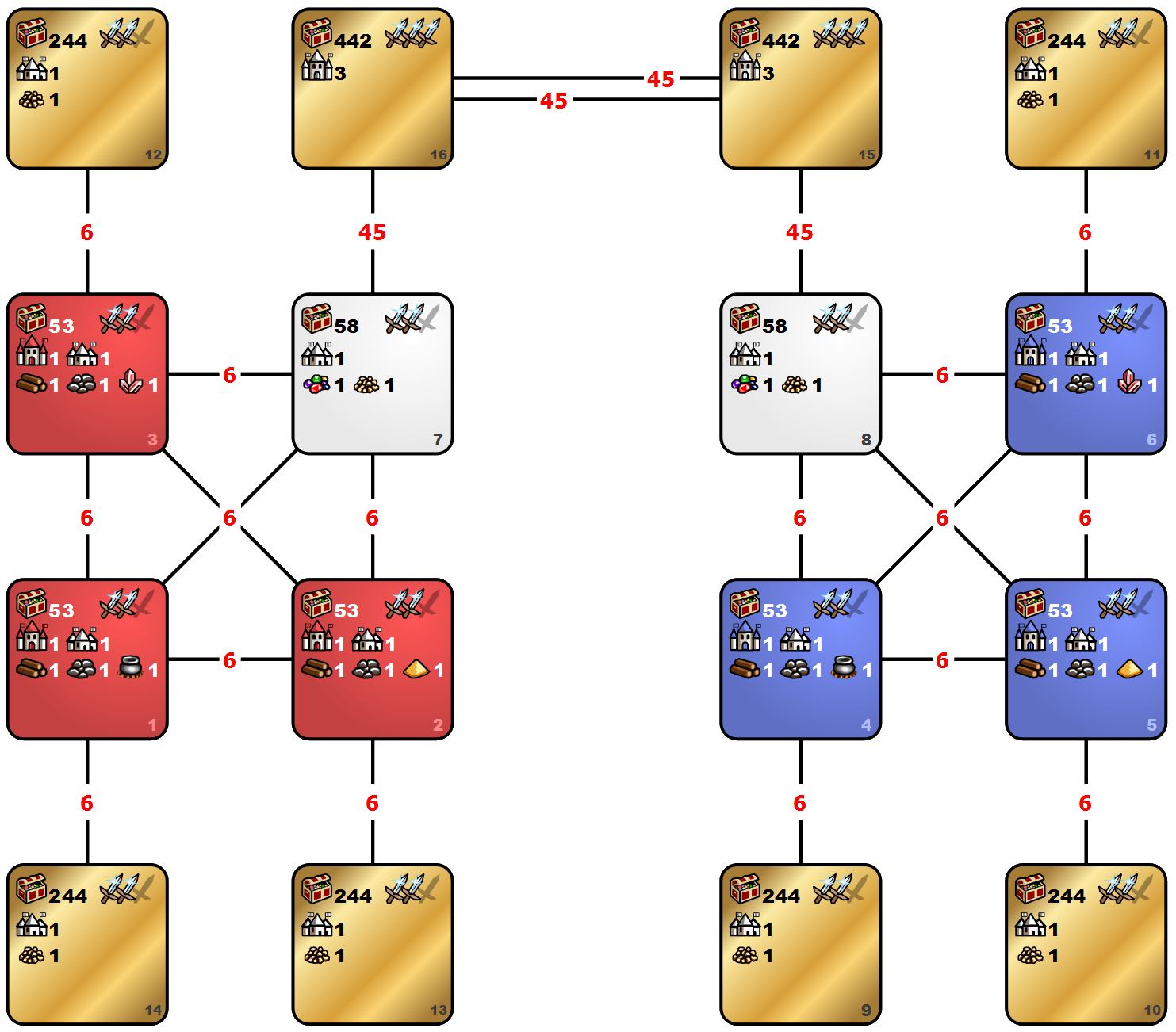
Specifications:
- Every player has 3 starting towns in different zones.
- Different towns of the same zone are allowed to have different alignments.
- Content types clarification:
- 53 (player zones): content types (100–3000, 12), (3000–6000, 6), (6000–8999, 1).
- 58 (white zones): content types (100–3000, 12), (3000–12000, 6), (10000–15000, 1).
- 244 (corner gold zones): content types (6000–8999, 9), (10000–17000, 9), (17000–20000, 3).
- 442 (central gold zones): content types (10000–22000, 9), (22000–35000, 6), (35000–50000, 3).
AnarchyN12
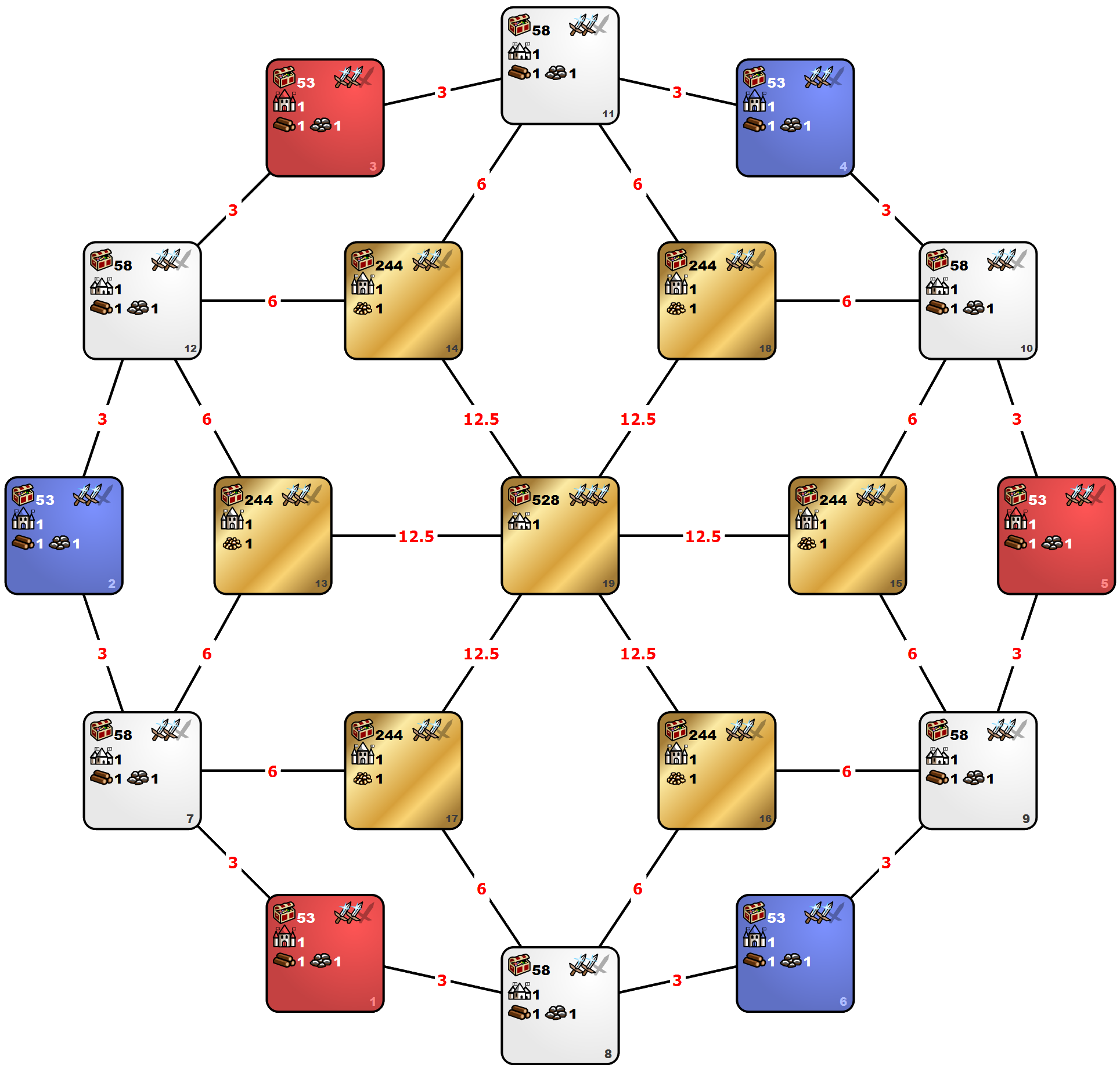
Specifications:
- Each player starts with 3 towns generated in different zones.
- Content types clarification:
- 53 (player zones): content types (100–3000, 12), (3000–6000, 6), (6000–8999, 1).
- 58 (white zones): content types (100–3000, 12), (3000–12000, 6), (10000–15000, 1).
- 244 (gold zones): content types (6000–8999, 9), (10000–17000, 9), (17000–20000, 3).
- 528 (central gold zone): content types (10000–22000, 9), (22000–35000, 9), (35000–50000, 3).
Black’n’Blue
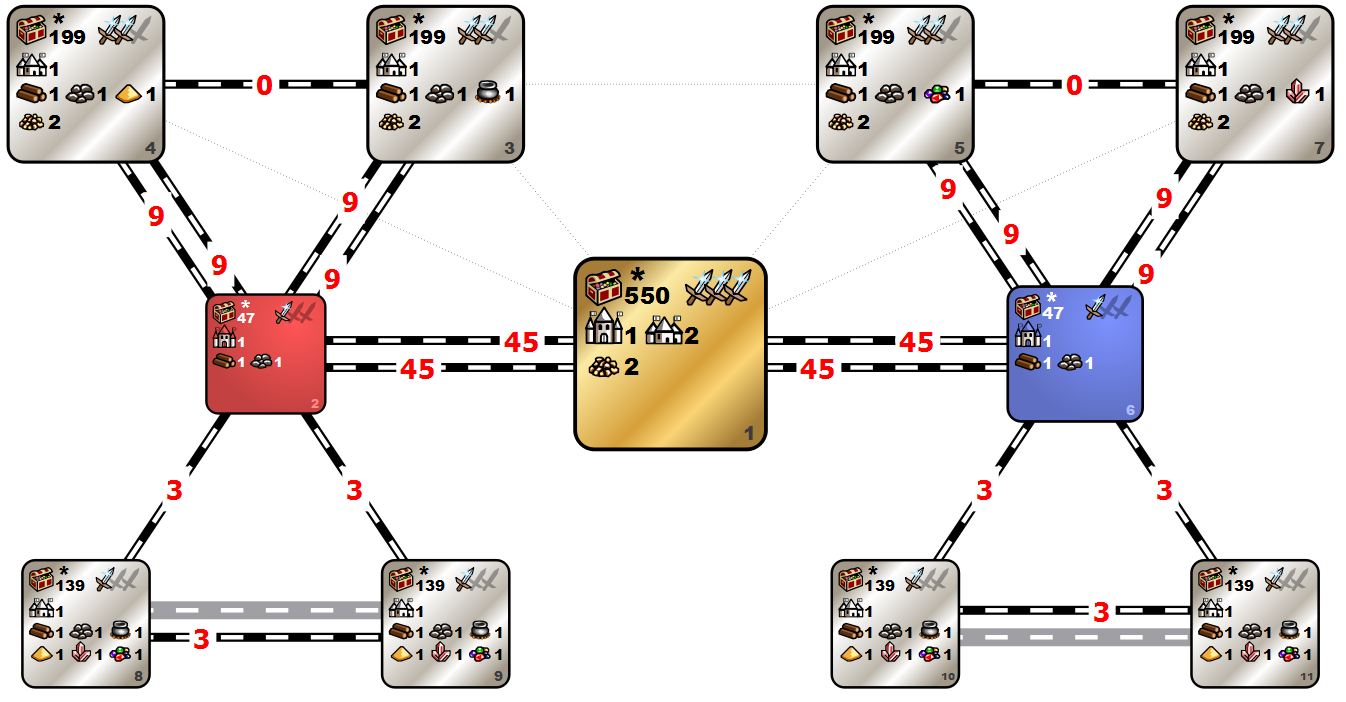
This template makes use of non-standard objects. Each player has access to the snow zones with Ancient Lamps, Pandora Boxes with Stone Golems and Dragon Utopias; as well as Subterranean zones with Pandora Boxes waving Skeletons and (seldom) Vampire Lords inside. Player areas are connected via large and rich treasure zone with Ancient Lamps, Creature Pandora Boxes, Dragon Utopias and Faerie Dragon Dwellings.
General specifications:
- Map size: L+U.
- Content types clarification:
- 47 (player zones): content types (500–3000, 7), (3000–6000, 6), (6000–10000, 1).
- 139 (lower silver zones): content types (250–3000, 4), (3000–12000, 6), (15000–20000, 5).
- 199 (upper silver zones): content types (3000–8000, 8), (6000–10000, 10), (8000–17000, 6).
- 550 (central gold zone): content types (5000–10000, 12), (10000–15000, 8), (15000–45000, 12).
- Zones 8–11 are always generated in the underground and always have subterranean terrain. The rest are always on the surface. Starting player zones (1–2) have the native terrain of their corresponding town. Zones 3–5, 7 are always snow zones. central zone 1 is always a sand zone.
- Zone 3–5, 7 towns are always Towers. Zone 8–11 towns are always Necropoles. Central zone 1 towns are always Confluxes.
- Banned heroes: Adele, Ryland, Cyra, and Melchior.
- Banned secondary skill: Diplomacy.
- Banned Fly and Dimension Door spells as well as Angel Wings artifact.
- Banned artifacts: Spellbinder’s Hat, Diplomacy set (Statesman’s Medal, Diplomat’s Ring, Ambassador’s Sash), Armor of the Damned (by banning Skull Helmet), Ironfist of the Ogre (by banning Tunic of the Cyclops King), Cloak of the Undead King (by banning Dead Man’s Boots).
- Special weeks are allowed.
- Combat round limit is 100.
Suggested rules and settings:
Custom object generation rules:
As a general rule: all objects are banned. Allowed objects are set separately for each zone.
Note: object generation settings are separated into 3 categories:
1. Allowed with default settings. This means that these objects are generated in certain zone similarly to any generic template. Neither object nor guard settings are changed.
2. Allowed with custom limits. These objects have almost the same settings as by default, but the maximum amount of them is limited. E.g., Churchyard with maximum of 1 per zone will have the same settings as on generic template, but there cannot be more than 1 Churchyard in this zone.
3. Allowed with custom frequency and/or value. In case the value is changed, this may affect the power of the monsters guarding this object — this is the most notable kind of change that can be applied to object generation settings, especially for more skilled players, who had already got used to default values. Frequency change may affect the number of objects of this type in a given zone, but, unlike changing the limits, this change is not so strict.
Zone 1. Central treasure zone, sand.
All resource piles, Treasure Chest and Campfire
Random artifact of any level
All objects increasing primary skill(s) for free (Mercenary Camp, Marletto Tower, Star Axis, Garden of Revelation, Library of Enlightenment, Arena, Colosseum of the Magi)
Level 2 and 4 shrines
Pandora’s Box with 10000 XP or 10000 gold
Cyclops Stockpile
Naga Bank
Black Market
Learning Stone
Witch Hut
Redwood Observatory
Allowed with custom limits:
Maximum per zone — 2: Prison — 15000 XP hero, Scholar
Maximum per zone — 4: Prison — 5000 XP hero, Pandora’s Box with 15000 exp, School of Magic
Allowed with custom value/frequency/limits:
Ancient Lamp, value: 5000, frequency: 200
Pandora’s Box with level 4 creatures, frequency: 40, maximum per zone: 5
Pandora’s Box with level 5 creatures, frequency: 60, maximum per zone: 5
Pandora’s Box with level 6 creatures, frequency: 40, maximum per zone: 4
Ivory Tower, value: 8000, frequency: 200, maximum per zone: 6
Dragon Utopia, frequency: 300
Eye of the Magi, value: 2500
Magic Forest (Faerie Dragon dwelling), frequency: 120
Zones 2 and 6. Starting zones for red and blue players.
All resource piles, Treasure Chest and Campfire
Random non-Relic artifact
Allowed with custom limits:
Maximum per zone — 1: Churchyard, Naga Bank, Dwarven Treasury, Trading Post, Redwood Observatory, Rally Flag, Tree of Knowledge, School of Magic, Arena, Fountain of Youth, Water Wheel, Windmill, Pandora’s Box with 5000 gold or 5000 exp, Level 3 Spell Scroll, Level 3 Dwelling, Level 2 Shrine
Maximum per zone — 2: Medusa Stores, Scholar, Witch Hut, Level 1 Spell Scroll, Level 2 Dwelling, Level 1 Shrine
Maximum per zone — 3: (Mercenary Camp, Marletto Tower, Star Axis, Garden of Revelation, Crypt, Black Tower, Gazebo, Wagon, Level 1 Dwelling
Maximum per zone — 4: Level 1 Spell Scroll
Zones 3, 4, 5 and 7. Medium treasure zones, snow.
All resource piles and Treasure Chest
Random Treasure atrifact
Level 1 and 2 Shrines
Naga Bank
Medusa Stores
Allowed with custom limits:
Maximum per zone — 1: Warehouses of rare resources (Mercury, Sulfur, Crystals, Gems), Arena, School of Magic, Tavern, Rally Flag, Tree of Knowledge, Water Wheel, Redwood Observatory, Dwarven Treasury, Windmill, Witch Hut
Maximum per zone — 2: Cyclops Stockpile, Prison — 0 XP hero, Scholar, Parapet (Stone Gargoyle dwelling)
Maximum per zone — 3: Mercenary Camp, Marletto Tower, Star Axis, Garden of Revelation, Black Tower, Learning Stone, Magic Well
Maximum per zone — 4: Workshop (Gremlin dwelling), random Major artifact
Maximum per zone — 5: Level 1 Spell Scroll
Maximum per zone — 6: Crypt
Maximum per zone — 8: Campfire
Allowed with custom value/frequency/limits:
Ancient Lamp, value: 5000, frequency: 320
Pandora’s Box with creatures: Stone Golems, frequency: 200, maximum per zone: 2
Dragon Utopia, frequency: 200, maximum per zone: 3
Ivory Tower, value: 8000, frequency: 200, maximum per zone: 4
Random Minor artifact, maximum per zone: 6
Zones 8, 9, 10 and 11. Lesser treasure zones, underground.
All resource piles and Treasure Chest
Level 1, 2 and 3 Spell Scrolls
Random Treasure artifact
Allowed with custom limits:
Maximum per zone — 1: Warehouses of rare resources (Mercury, Sulfur, Crystals, Gems), Rally Flag, Skeleton Transformer, Pillar of Fire, Arena, Tavern, School of Magic
Maximum per zone — 2: Warehouses of Wood and Ore, Prison — 0 XP hero, Level 3 Shrine, Witch Hut, Scholar
Maximum per zone — 3: Mercenary Camp, Marletto Tower, Star Axis, Garden of Revelation, Pandora’s Box with creatures: Vampire Lords, Level 2 Shrine, Black Tower, Naga Bank, Churchyard, Magic Well, Cursed Temple (Skeleton dwelling)
Maximum per zone — 4: Tomb of Souls (Wight dwelling), Level 1 Shrine, Dwarven Treasury, Learning Stone
Allowed with custom value/frequency/limits:
Pandora’s Box with creatures: Skeletons, frequency: 200, maximum per zone: 4
Imp Cache, value: 3000, frequency: 200, maximum per zone: 5
Refugee Camp, value: 3000, frequency: 200, maximum per zone: 4
M200 templates
2sm2c(2)
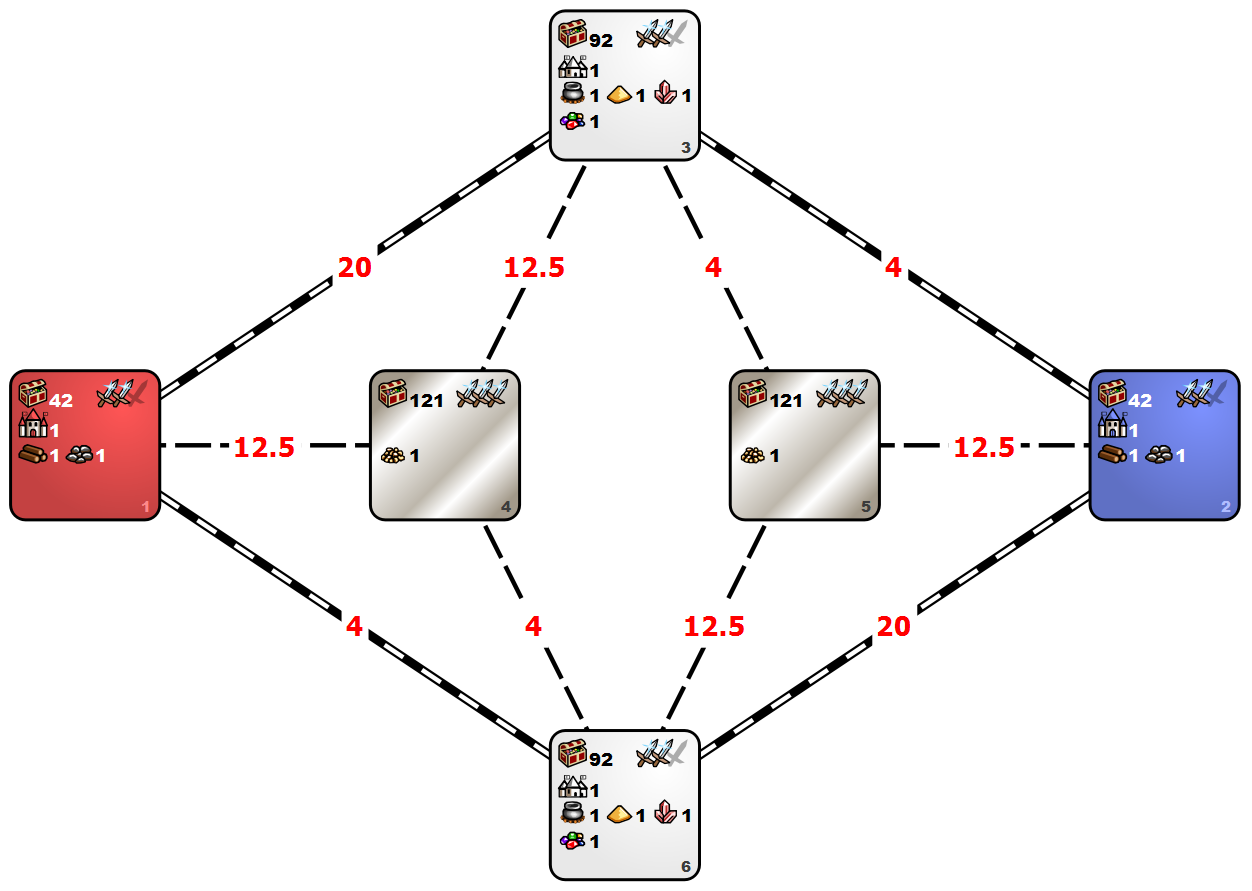
M-size template designed to use with 200% difficulty. The starting conditions are poor, and the possibilities are either rush directly to opponent’s zone (in case the guards are suitable), or explore the roadless treasure zone. The games are usually quick, and the outcome depends on spells found.
Specifications:
- Map size: M-U.
- Content types clarification:
- 42 (player zones): content types (800–800, 9), (1000–2100, 4), (3500–4900, 7).
- 92 (white zones): content types (800–2100, 5), (4000–5000, 6), (6000–8000, 9).
- 121 (silver zones): content types (350–2000, 9), (8000–9150, 10), (1000–40000, 1).
- Starting player zones (1–2) have the native terrain of their corresponding town. Neighboring zones (3, 6) are generated with random terrain. Treasure zones (4–5) are always dirt zones.
- Players cannot select Necropolis or Conflux as their starting alignment.
- Banned heroes: Loynis, Solmyr, Kalid, Moandor, Aislinn, Moandor, Deemer, Darkstorn, Kinkeria, Merist, Kalt, Luna, Jeremy, Victoria.
- Banned secondary skills: Learning.
- Banned spells: Fly, Dimension Door and Town Portal. Banned artifact: Angel Wings.
- Banned objects: Obelisk, Trading Post.
- Special weeks are disabled.
- Combat round limit is 100.
Suggested rules and settings:
Skirmish(M)
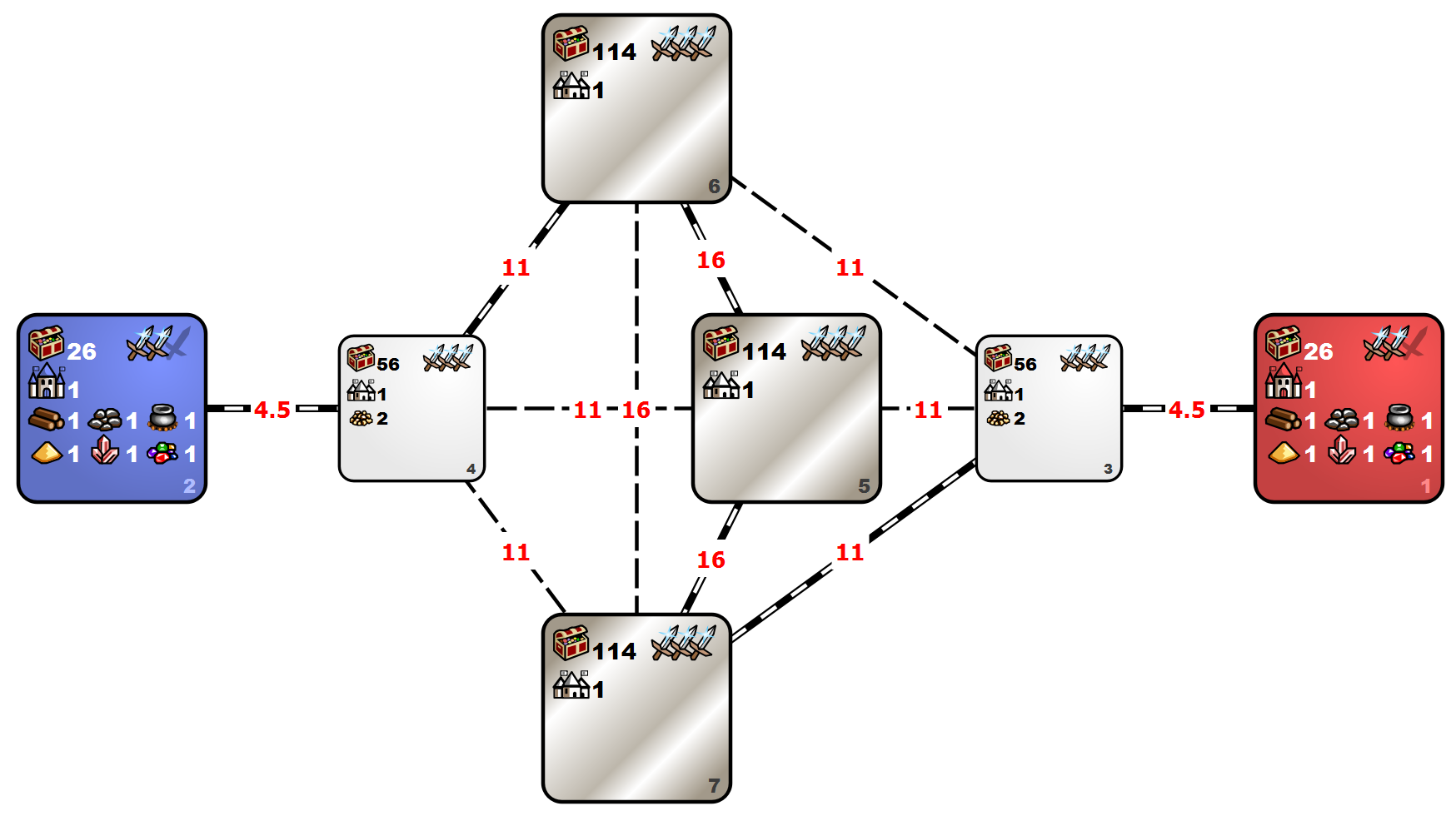
M-size template designed to use with 200% difficulty. Poor player areas are connected by 3 rather valuable treasure zones. The pairs of zones usually have multiple connections, some of which have roads. The games are usually quick, and the outcome depends on spells found.
Specifications:
- Map size: M-U.
- Content types clarification:
- 26 (player zones): content types (330–1000, 3), (1000–2000, 7), (3300–3500, 4).
- 56 (white zones): content types (330–1500, 5), (1500–2000, 2), (5000–7000, 8).
- 114 (silver zones): content types (350–2000, 3), (8000–9150, 10), (1000–40000, 1).
- Starting player zones (1–2) have the native terrain of their corresponding town. The rest (3–7) have their terrain randomly selected from the list: dirt, grass, lava, highlands.
- Players cannot select Necropolis or Conflux as their starting alignment. The towns in neighboring zones (3–4) are always Necropoles.
- Banned heroes: Loynis, Solmyr, Kalid, Moandor, Aislinn, Moandor, Deemer, Darkstorn, Kinkeria, Merist, Kalt, Luna, Jeremy, Victoria.
- Banned secondary skills: Learning.
- Banned spells: Fly, Dimension Door and Town Portal. Banned artifact: Angel Wings.
- Banned objects: Obelisk, Trading Post.
- Special weeks are disabled.
- Combat round limit is 100.
Suggested rules and settings:
Nine-day Wonder
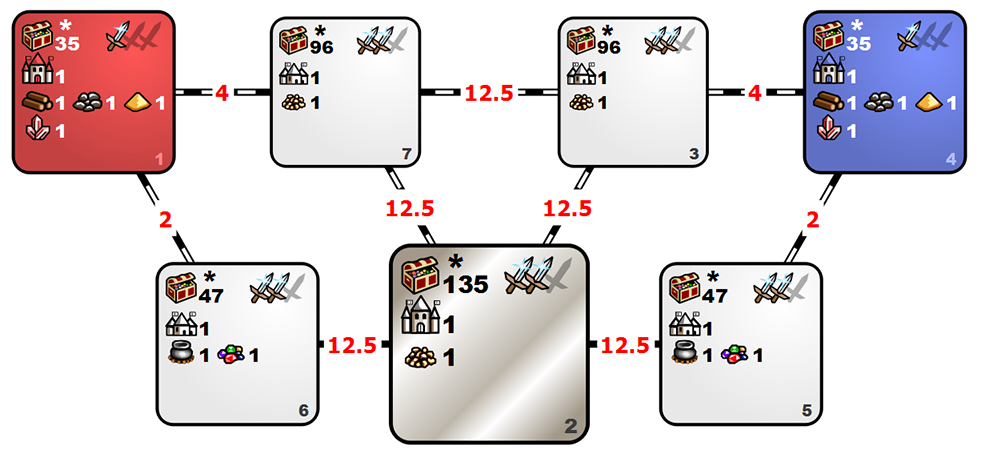
M-size template designed to use with 200% difficulty. Special object generation settings improve the ballance, compared to other M-size templates. The players are able to enter the grass zone with poor treasures and the dirt zone with Dragon Fly Hives and Wolf Raider Pickets that have weaker-then-default guards; passage to both zones is lightly guarded. From these zones they may access the lava treasure zone with normally guarded Pickets and other valuable objects. One may also rush to the opponent’s zone via the dirt zone.
General specifications:
- Map size: M-U.
- Content types clarification:
- 35 (player zones): content types (300–2000, 10), (2000–5000, 5), (5000–9000, 1).
- 47 (lower white zones): content types (100–3000, 10), (3000–6000, 7).
- 96 (upper white zones): content types (500–6000, 9), (6000–10000, 7), (10000–12000, 1).
- 135 (central silver zone): content types (2000–6000, 11), (6000–15000, 7), (15000–20000, 1).
- Starting player zones (1, 4) have the native terrain of their corresponding town. Neighboring zones 3 and 7 are always dirt zones. Neighboring zones 5–6 are always grass zones. Treasure zone 2 is always a lava zone.
- Banned heroes: Loynis, Solmyr, Kalid, Moandor, Aislinn, Moandor, Deemer, Darkstorn, Kinkeria, Merist, Kalt, Luna, Jeremy, Victoria.
- Banned secondary skills: Pathfinfing, Diplomacy, Eagle Eye, Learning.
- Banned spells: Fly, Dimension Door and Town Portal. Banned artifact: Angel Wings.
- Banned artifacts: Resistance set (Garniture of Interference, Surcoat of Counterpoise, Boots of Polarity), Eagle Eye set (Bird of Perception, Stoic Watchman, Emblem of Cognizance), Legion set (Legs of Legion, Loins of Legion, Torso of Legion, Hands of Legion, Head of Legion), Wayfarer’s Boots, Cloak of the Undead King (by banning Amulet of Undertaker).
- Special weeks are disabled.
- Combat round limit is 100.
Suggested rules and settings:
Custom object generation rules:
Note: object generation settings are separated into 3 categories:
1. Banned objects doesn’t appear in the specified zone.
2. Allowed with custom limits. These objects have almost the same settings as by default, but the maximum amount of them is limited. E.g., Churchyard with maximum of 1 per zone will have the same settings as on generic template, but there cannot be more than 1 Churchyard in this zone.
3. Allowed with custom frequency and/or value. In case the value is changed, this may affect the power of the monsters guarding this object — this is the most notable kind of change that can be applied to object generation settings, especially for more skilled players, who had already got used to default values. Frequency change may affect the number of objects of this type in a given zone, but, unlike changing the limits, this change is not so strict.Object bans and permissions apply in the order of appearance on the list. I.e., some global bans may be overridden by further permissions (e.g., banning all dwellings, then allowing 1 level dwellings will cause only level 1 dwellings to generate). This principle applies both on general template settings and on specifications for each zone.
General template rules:
Quest artifact for Seer Hut of any kind (therefore Seer Hut itself)
Obelisk
Trading Post
Experimental Shop
Tree of Knowledge
Freelancer’s Guild
Lean To
Temple of Loyalty
Allowed with custom map or zone limits:
Maximum per map — 4: Cyclops Stockpile
Maximum per zone — 1: Shrines of all levels, School of War, Prisons — 0, 5000 and 15000 XP heroes.
Allowed with custom value/frequency/limits:
Imp Cache, value: 750, frequency: 30, maximum per zone: 2
University, value: 1500, frequency: 10, maximum per zone: 1
Warehouse of Gold, value: 2000, frequency: 30
Warehouses of Wood and Ore, value: 1000, maximum per zone: 1
Warehouses of rare resources (Mercury, Sulfur, Crystals, Gems), value: 1500, maximum per zone: 1
Zones 1 and 4. Starting zones of red and blue players.
Any dwellings
Churchyard
Level 4 Shrine
Naga Bank
Mansion
Allowed with custom value/frequency/limits:
Random Treasure artifact, value: 1500, frequency: 500, maximum per zone: 2
Level 1 Dwelling, frequency: 1000, maximum per zone: 1
Black Tower, frequency: 250, maximum per zone: 2
Treasure Chest, value: 1000
Altar of Sacrifice, frequency: 200
Griffin Conservatory, maximum per zone: 2
Zones 6 and 5. Neighboring zones, grass.
Mystical Garden
Allowed with custom value/frequency/limits:
Churchyard, frequency: 200
Crypt, frequency: 300
Zones 7 and 3. Neighboring zones, dirt.
Naga Bank
Mansion
Town Gate
Allowed with custom value/frequency/limits:
Dragon Fly Hive, value: 6000, frequency: 300, maximum per zone: 3
Black Market, value: 6000, frequency: 40
Wolf Raider Picket, value: 6500
Zone 2. Central treasure zone, lava.
Any dwellings
Allowed with custom value/frequency/limits:
Town Gate, value: 5000, frequency: 10000, maximum per zone: 1
Griffin Conservatory, frequency: 300, maximum per zone: 3
Wolf Raider Picket, frequency: 300, maximum per zone: 3
Random Major artifact, value: 5000, maximum per zone: 3
Dragon Utopia, maximum per zone: 2